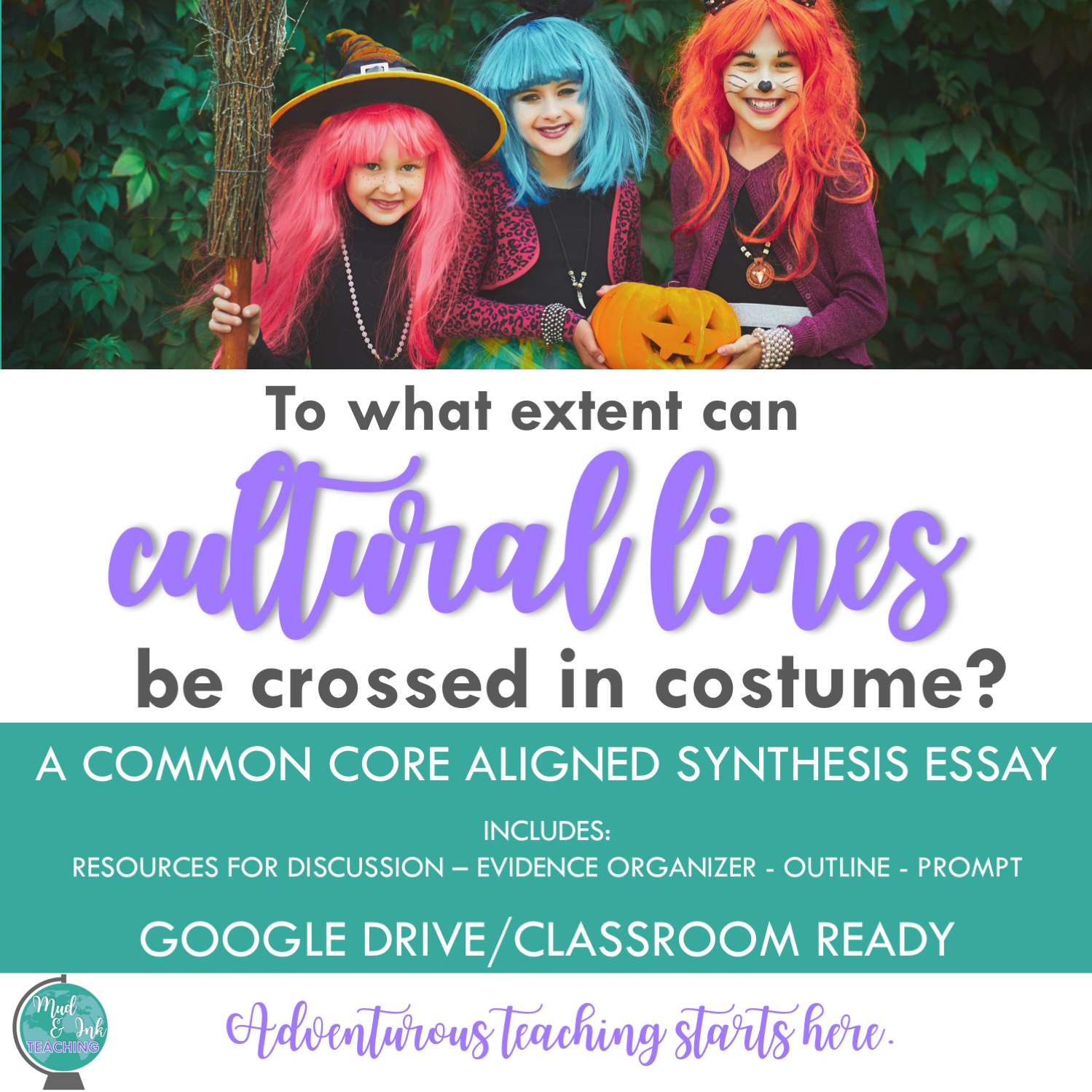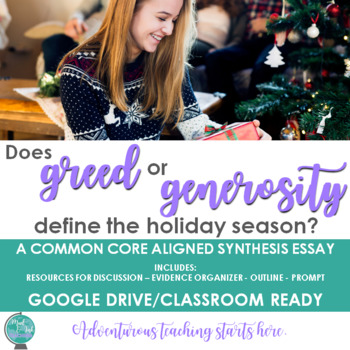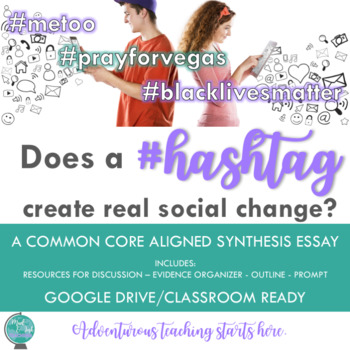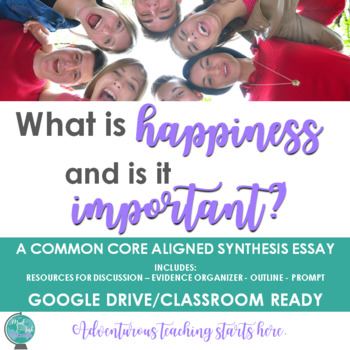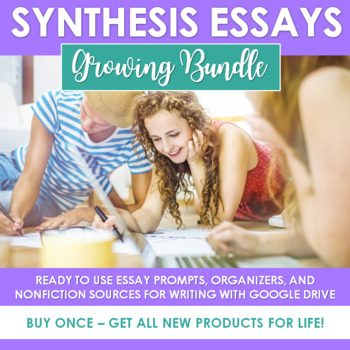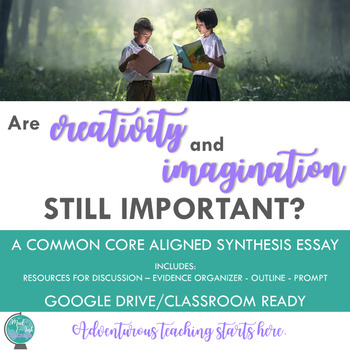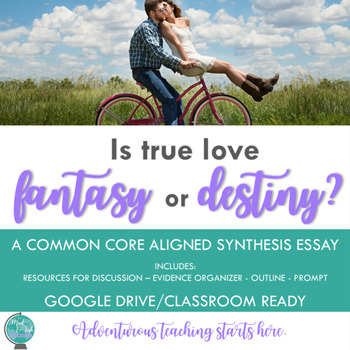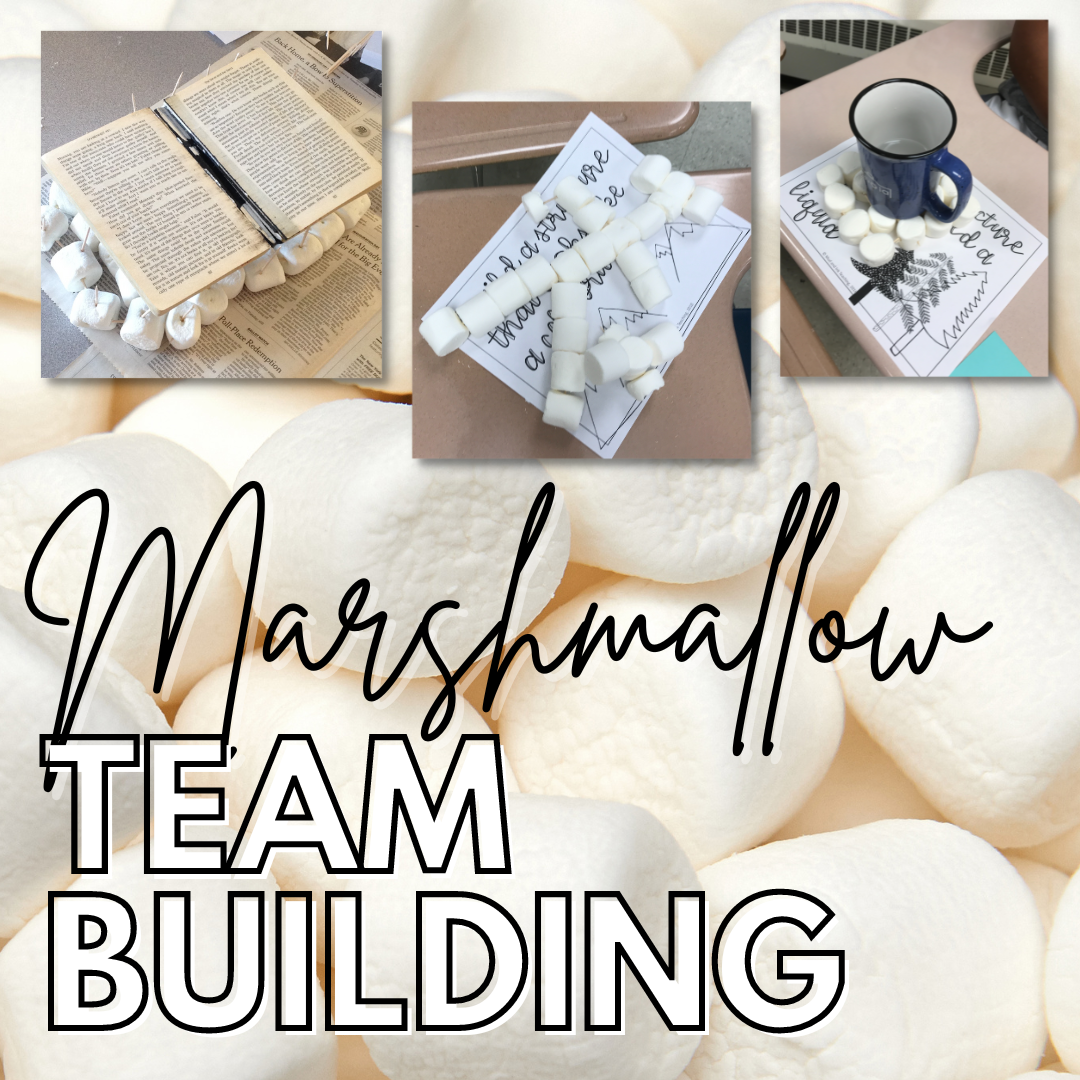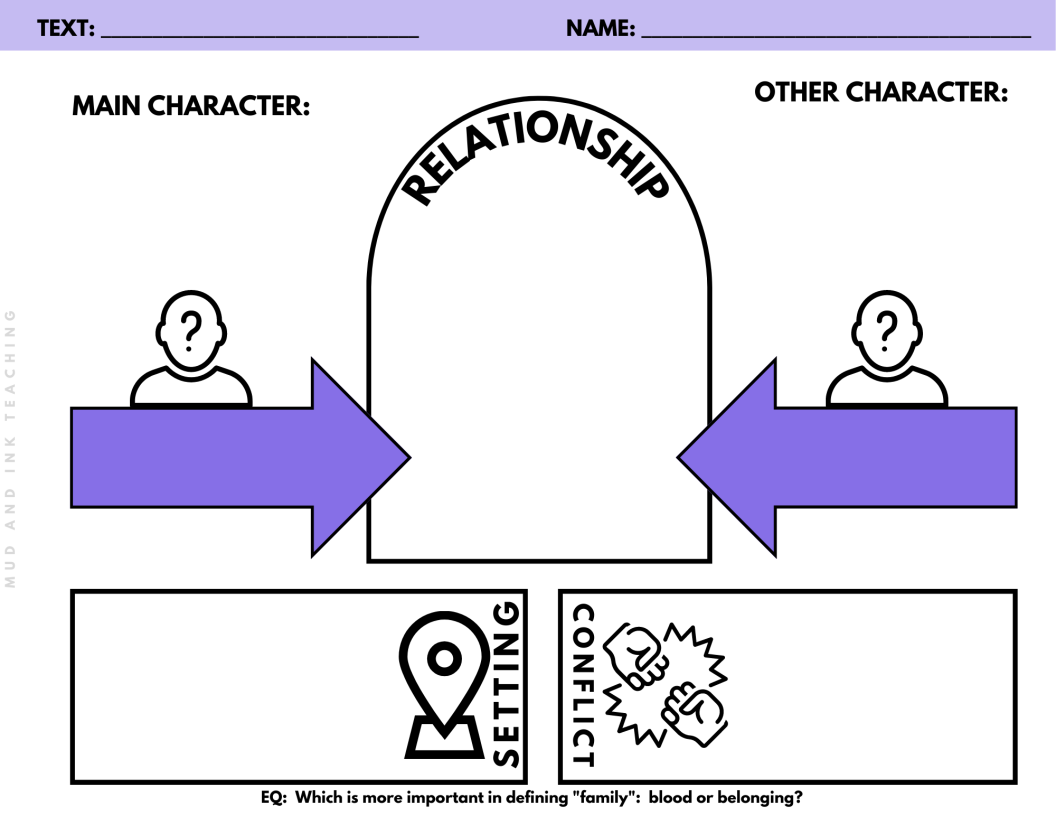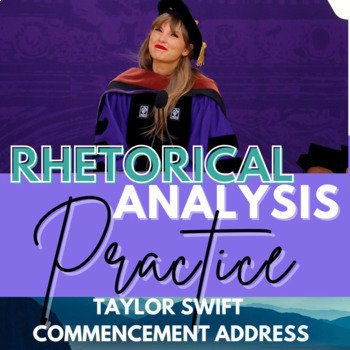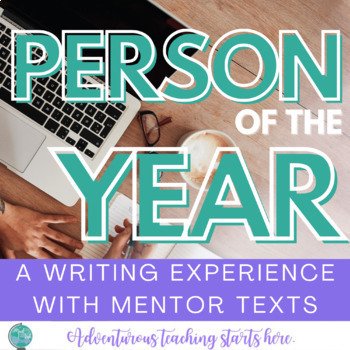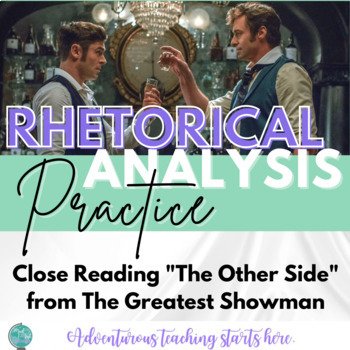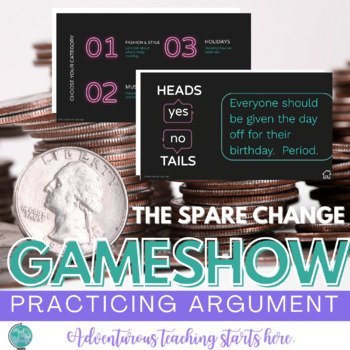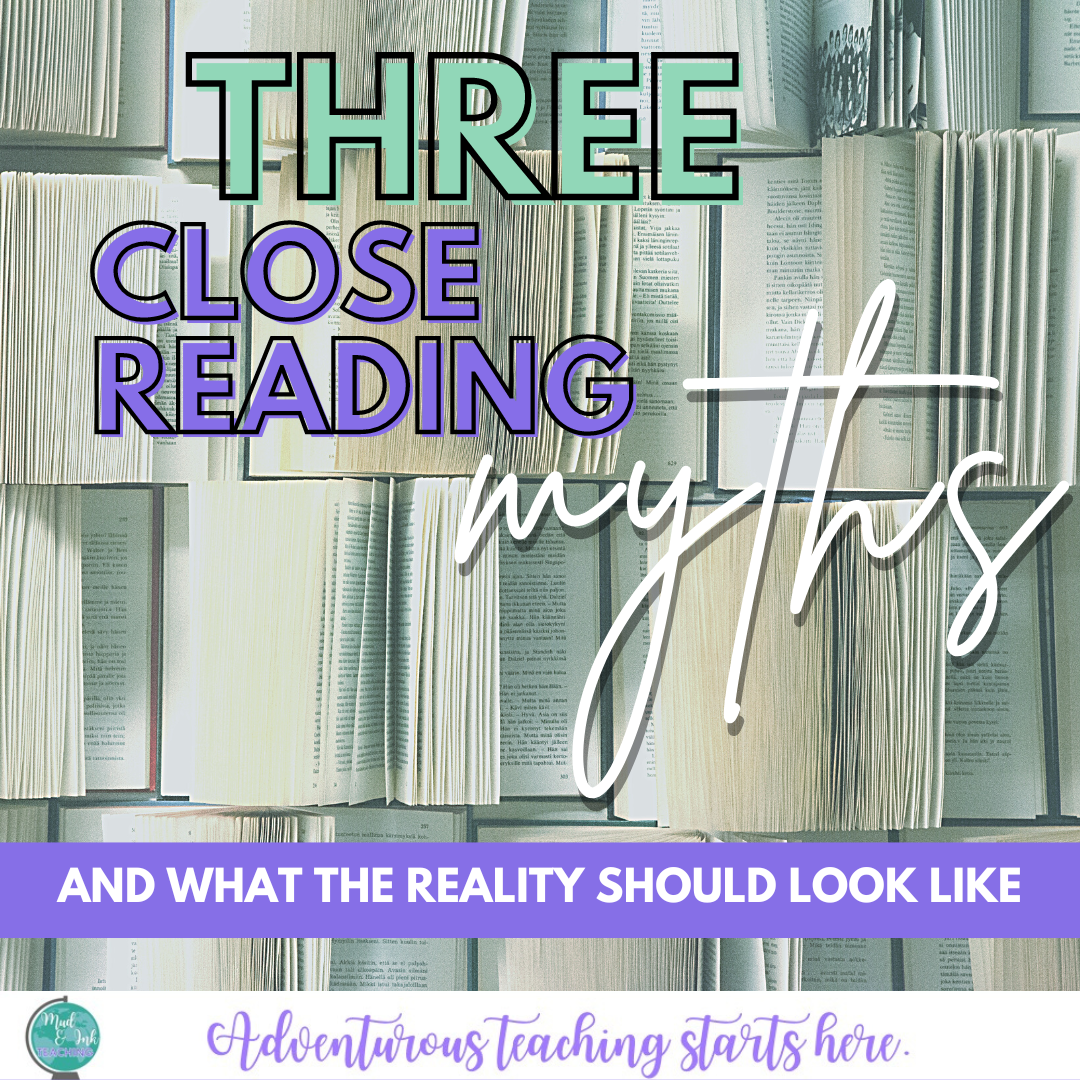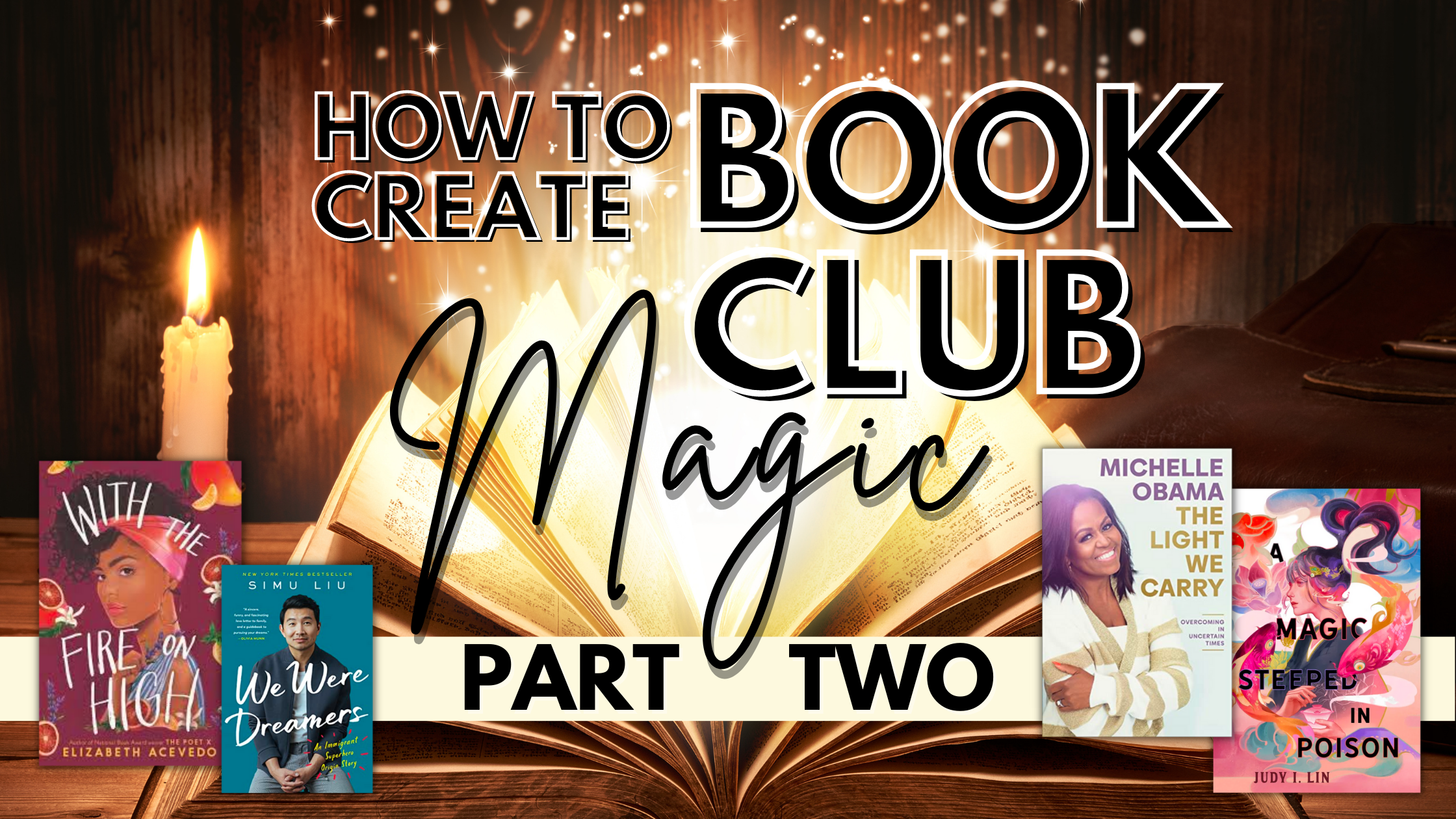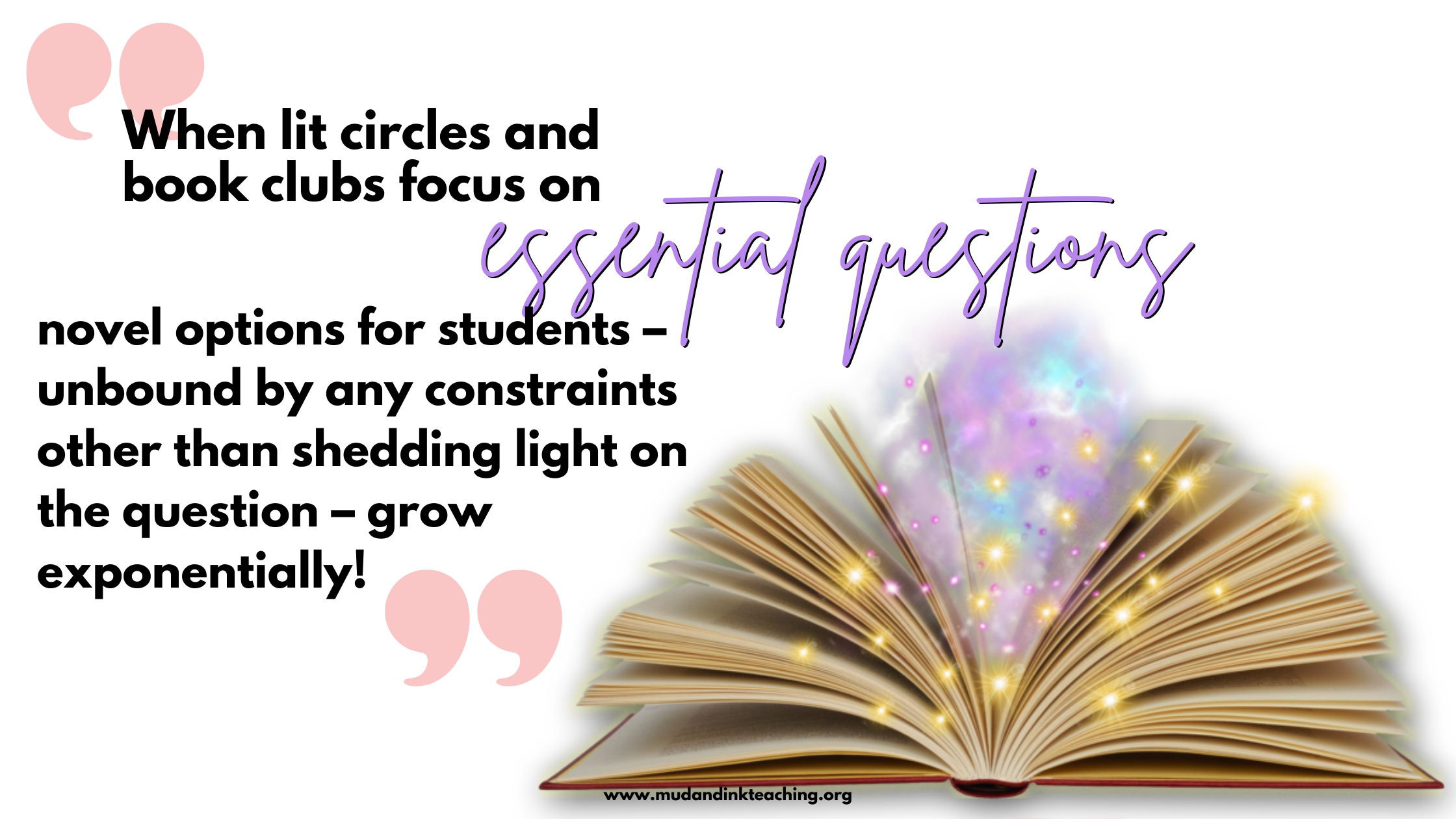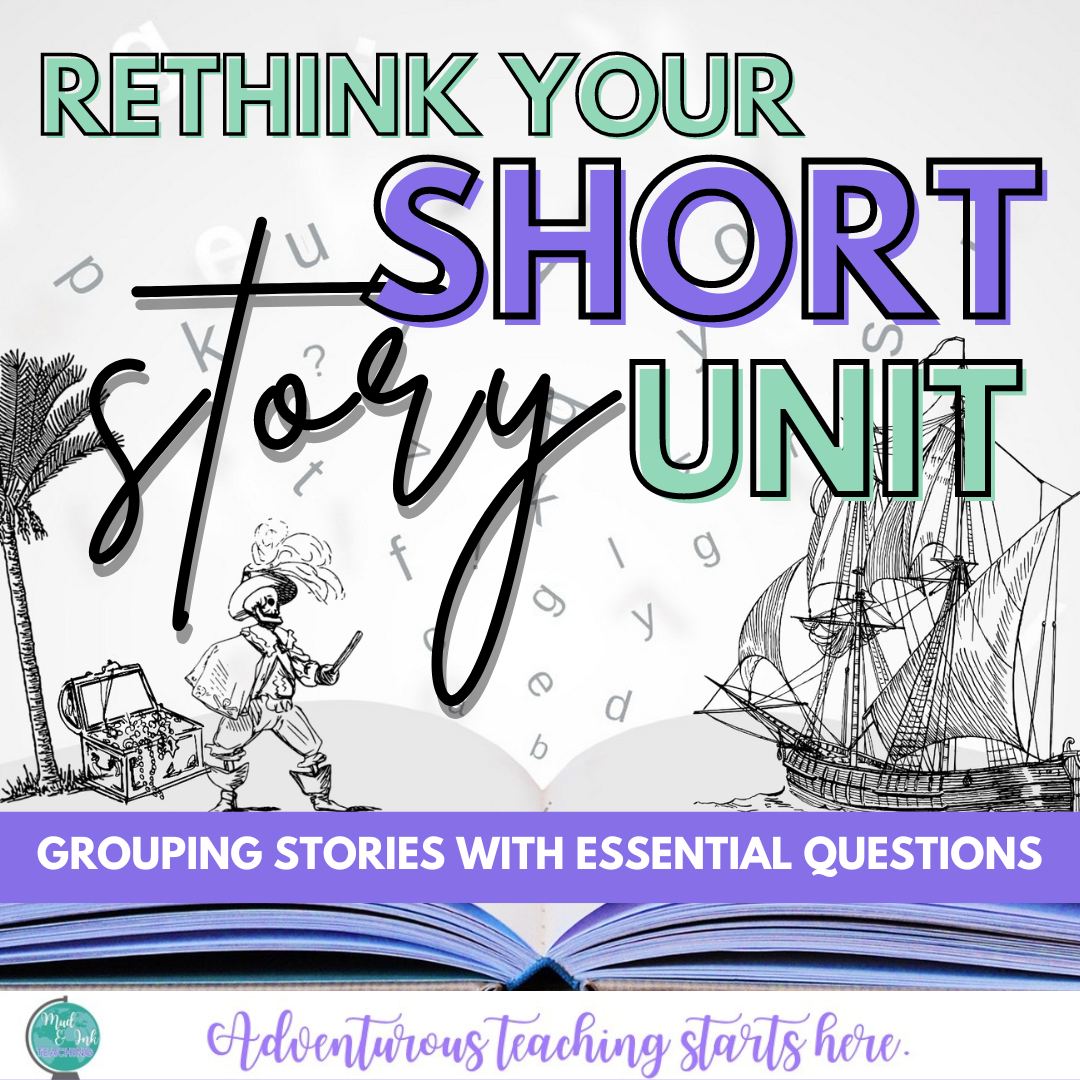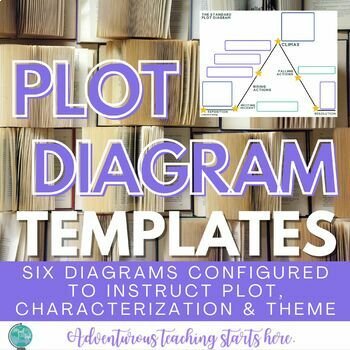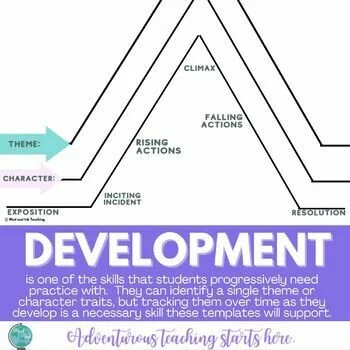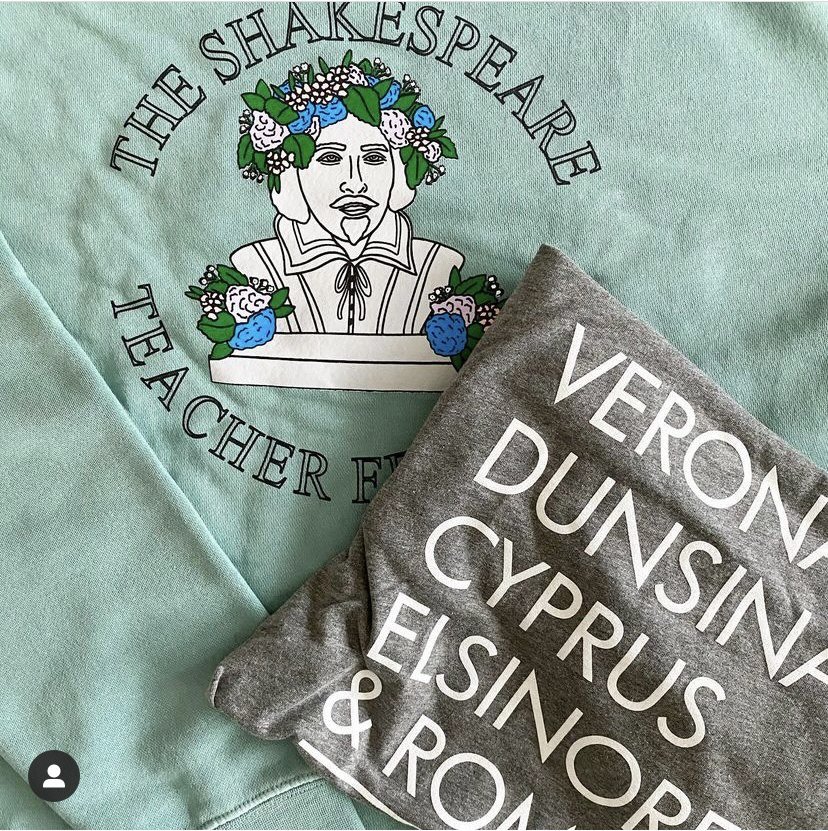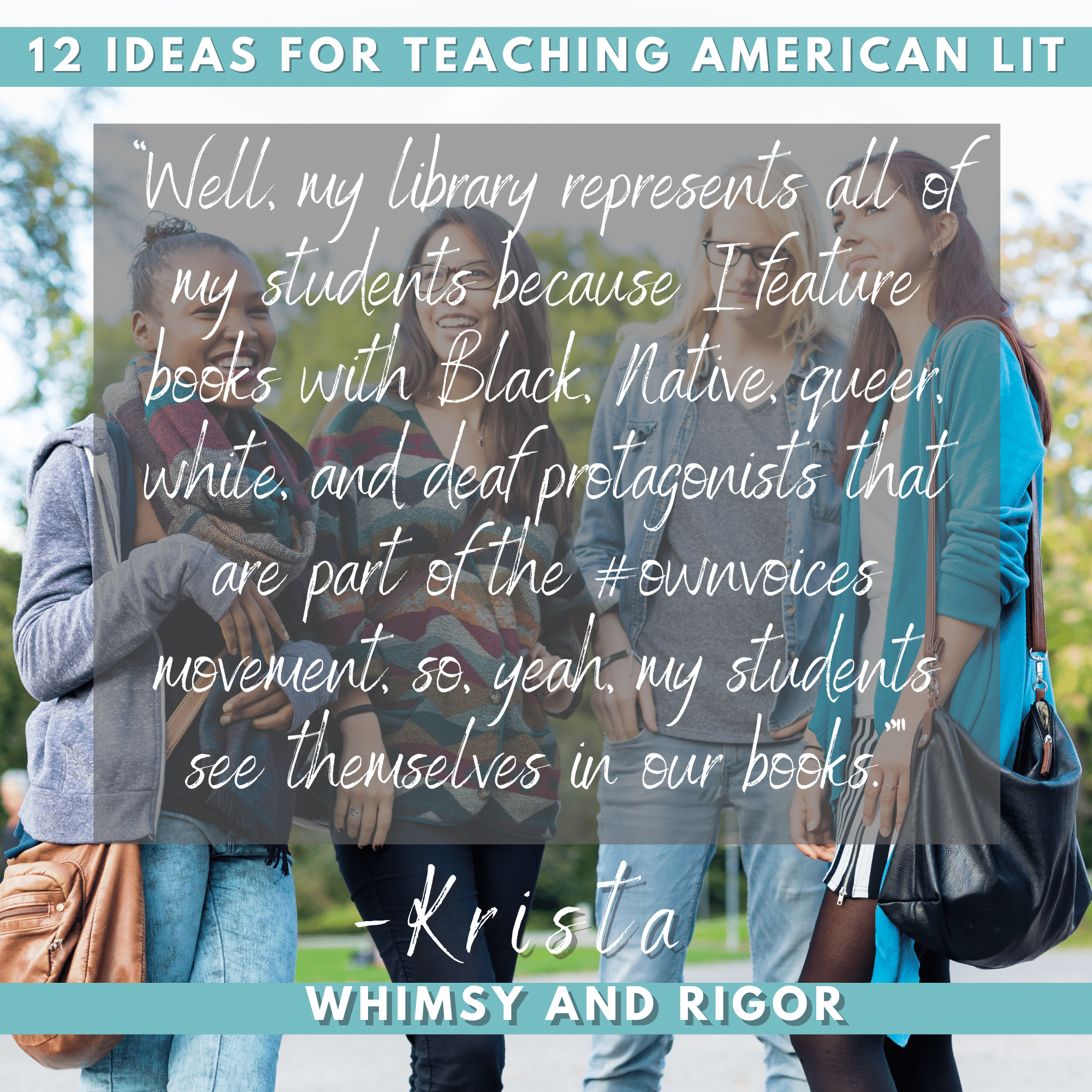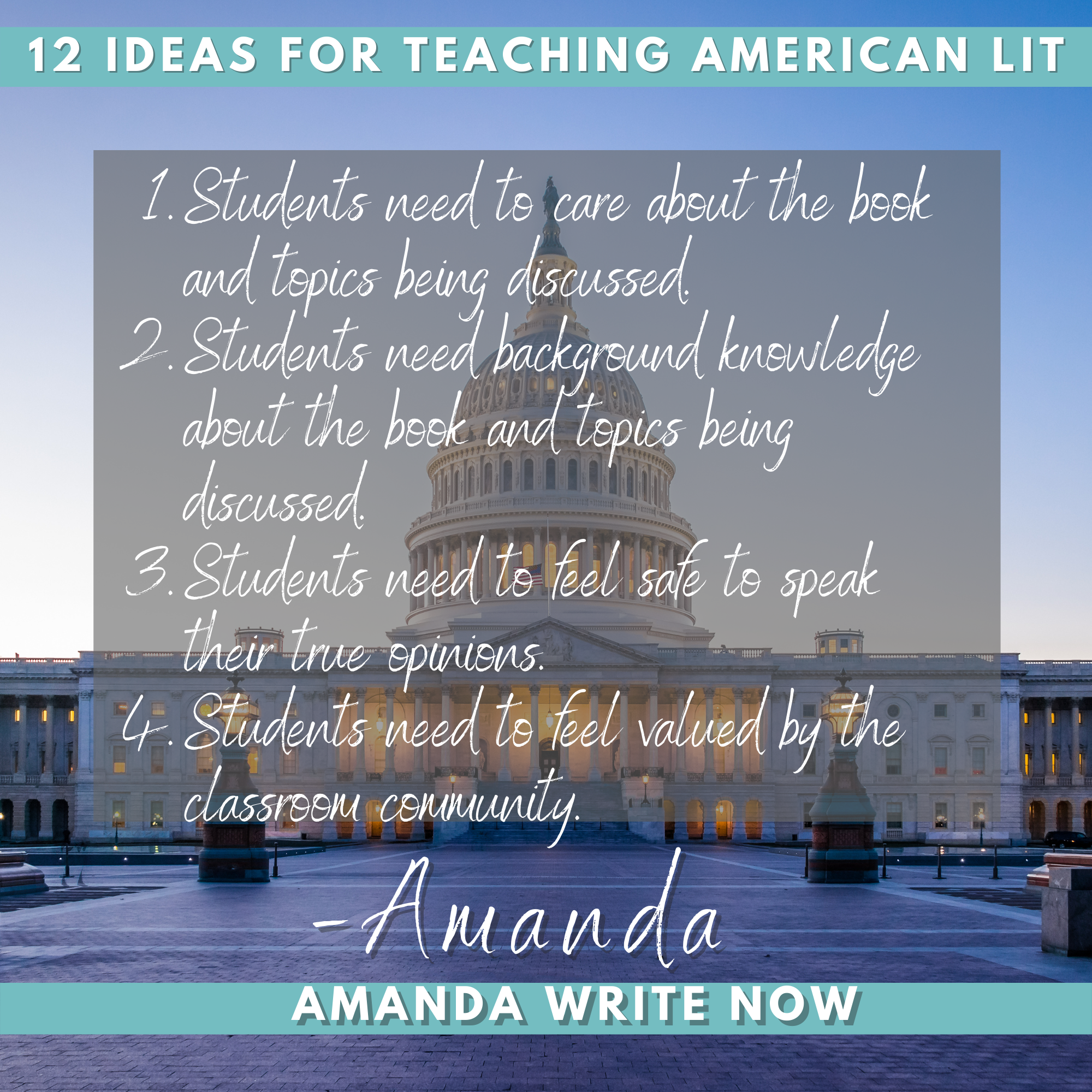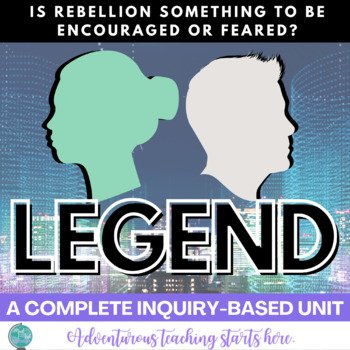
ADVENTUROUS TEACHING STARTS HERE.
5 Ways to Look at the Magic of Clarisse in your Fahrenheit 451 Unit
Now, more than ever, we need to have Fahrenheit 451 in front of our students. From the new onset of AI technology to the daily threats of our intellectual and academic freedom, Fahrenheit provides windows, mirrors, and doors into our present and our future. While Montag’s transformation, the working symbolism, and general dystopian world-building are all incredibly important pieces to focus on, I’d like to argue that it’s possible we need Clarisse McClellan the most.
Now, more than ever, we need to have Fahrenheit 451 in front of our students. From the new onset of AI technology to the daily threats of our intellectual and academic freedom, Fahrenheit provides windows, mirrors, and doors into our present and our future. While Montag’s transformation, the working symbolism, and general dystopian world-building are all incredibly important pieces to focus on, I’d like to argue that it’s possible we need Clarisse McClellan the most.
Clarisse.
The enigma.
The one character my students always feel collective sorrow for losing.
She brings us so much in this story but in the chaos of teaching and planning, her magic can be looked over. I’m here to help! Here are the most powerful places to let Clarisse step into the moonlight (too cheesy?):
SKILLS: CHARACTERIZATION - FOIL AND/OR STATIC
One of the very first close reading lessons that we do is a side-by-side close reading between the first introduction of Montag and the first introduction of Clarisse. Between the imagery drawn from nature to the colors used in their description, this is a great place to clearly teach the purpose of a foil or static character. Clarisse’s constancy — her unwavering commitment to being exactly who she is and refusing to conform — is what allows us to see Montag’s transformation. There is a distinct “Montag before Clarisse” and “Montag after Clarisse”. Not all literature gives us such a clear angle to teach this piece of literary craft and I highly recommend using close reading to do this.
SKILLS: FIGURATIVE LANGUAGE - SYMBOLISM
Clarisse is nature. She is water. She is the dew drops on the grass. She is the wind. As we learn about symbolism and track it throughout the novel, Clarisse’s symbols connect our readers to hope and humanity. Clarisse's appreciation for the natural world and her desire to connect with it on a personal level stand in stark contrast to the technology-obsessed, disconnected world of the novel. Clarisse (and her many objects) are a symbol of hope and resistance against a dystopian society. Her existence and actions inspire the protagonist Montag, and by extension, readers, to consider the possibility of change and a better future.
THEMES: HUMAN CONNECTION
If you’ve ever looked around your classroom, I bet you’ve seen phones peeking out of hoodie pockets, fingers flipping through TikTok, and wondered: what on Earth does the future have in store for us? Clarisse is our character to bring everyone back to our humanity (while Mildred does a fine job of warning students of the consequences of continued obsessive technology behavior). Clarisse seeks genuine human connections and meaningful conversations in a world where people are more interested in mindless entertainment and shallow interactions through screens. Her character highlights the importance of real, face-to-face relationships, and every year that I’ve taught this, students DO connect to her. Students DO express the feeling that they’d much rather a world full of Clarisses than a world full of Mildreds.
All of the contrast provided by Clarisse gives us ample opportunity to close read and discuss the roles of other characters. When we look at the Montag and Mildred’s marriage, it is one thing by itself, and an entirely different thing when we consider Clarisse’s impact. Beatty and Montag also have a distinct relationship, and that is shifted entirely as Clarisee’s impact works its way between them.
THEMES: INDIVIDUALITY & QUIET REBELLION
In my Fahrenheit 451 unit, we examine the Essential Question: To what extent is rebellion a requirement for society to progress? Again, Montag typically sits at the center of this conversation, but none of his transformation would be possible without Clarisse. Clarisse values her individuality and refuses to conform to the mindless consumerism and thoughtlessness of her society. Her character serves as a reminder of the importance of maintaining one's unique identity in the face of societal pressures - something that is becoming increasingly harder to do for us as adults and especially for students. She thinks deeply and critically about the world around her. She questions the conformity and superficiality of her society, encouraging readers to do the same in their own lives. Her love for books and the ideas they contain represents a rebellion against a society that burns books to control information and thought. This underscores the importance of literature and the free exchange of ideas.
THEMES: THE POWER OF FEAR
Clarisse might be the first person that Montag has ever heard ask a question, much less questioning authority. She challenges the oppressive government and the censorship of books - and in doing so, is killed. The cost of her quiet rebellion, the cost of keeping the lights on, having conversations, and asking questions…the cost was her life. This underscores the power of fear: when we are afraid of what we don’t understand, fear can convince us to take extreme action in an effort to protect our comfort zone. This might be one of the most important themes for students to take away from studying the novel. Clarisse made Montag uncomfortable, but she also brought him out of the dark and into the light. As we work through Beatty’s speech in Part 1, I like to ask students what Clarisse’s reaction would be to what Beatty is reporting. In so many of Montag’s major close reading moments (moments of transformation), his last trailing thought always comes back to Clarisse and the feeling of her closeness and the painful reality of her loss.
Ready to go all-in on Fahrenheit?
If you’re ready to take the leap and transform the way you’ve always taught Fahrenheit or start teaching it for the first time, I have you covered. My complete unit is designed to take you through 5-6 weeks of inquiry driven, student-centered learning. Learn more about the unit here and be sure to click PREVIEW to take a look inside!
RHETORICAL ANALYSIS RESOURCES
55+ Books for Your Next American Dream Unit for High School ELA
One of my favorite units to teach is a unit that focuses on the American Dream. It’s the perfect way to hone in on complex characterization and the layers of complexity are widely accommodating for skill level. Whether you’re building the unit to teach as a whole class novel unit or as a literature circles unit, this book list is here to save you time and energy in narrowing down the search.
THE AMERICAN DREAM: INSPIRING OR DESTRUCTIVE?
One of the most frequently taught units in the American high school system is one centered on The American Dream. In some cases, this can be the focus for an entire 11th grade year study of literature. And while it’s a necessary and important lens for us to use when examining literature, it can get stale or even oversimplified when working with students. After several years of experimenting, I have found this Essential Question approach to excite and engage students across skill levels, interests, and backgrounds. Whether you’re building the unit to teach The Great Gatsby, A Raisin in the Sun, or another American classic or you’re ready to tackle this topic as a literature circle unit, this book list is here to save you time and energy in narrowing down the search. The books on this list open up the conversation about the American Dream widely and represent a variety of experiences and voices.
Themes VS Essential Questions
For a long time, I taught theme-based units: units were based on a teacher’s pre-selected theme and all of the learning was connected underneath the umbrella of the theme. I really liked the sense of connectedness, and quite honestly, I was craving that coming from a much less organized situation when I began my career. But no matter how hard I tried, I couldn’t shake the teacher-centeredness of this approach. The students had very little investment in the choice of the theme, and the direction of the conversation around the theme, and so much of it was tied to the teacher’s decided trajectory for the unit.
Inquiry, on the other hand, gave me the chance to use the best parts of themes, but deepen them and hand them over to students. Inquiry takes a thematic idea, roots it in a question, and then asks students to spend the duration of the unit investigating and exploring potential answers to that question as they progress toward the summative. Look at it this way as a “unit makeover” :
BEFORE: Unit 1: THE AMERICAN DREAM
AFTER: Unit 1: IS THE AMERICAN DREAM MORE LIKELY TO INSPIRE OR DESTROY?
The thematic/topical unit states the focal point of the unit and we can assume that each of the texts in that unit will reveal different versions of the American Dream. The inquiry unit will do those same things as the thematic unit, but nudges students a massive step further: is it more likely to inspire us to do great things or destroy us along the way? The argumentative edge to this question presses students out of simple definitions and into the messy business of stating a claim on a continuum. This one big question begs dozens of smaller ones and sets up a unit that is connected, but also divergent. Most importantly, this question helps the unit address the critical nature of the way the dream manifested in drastically different ways depending on a person’s race, immigration status, and ancestry. This is a unit that is unified under a topic (The American Dream), but also ready to twist and turn with student curiosity. In the video below, I give a big longer take on the ways this question opens up possibilities within a unit:
Scroll through the list below of titles that are absolute perfection for this particular unit. Bookshop.org is a wonderful partner working to bring business to small, local bookstores, so if you can swing it, shop the list directly and you’ll be able to help out bookstores in your area!
Elevating Your Gatsby Unit: Examining Inspiration and Destruction
The duality of the American Dream - its capacity to both inspire and destroy - lies at the core of F. Scott Fitzgerald's iconic novel, The Great Gatsby. When teaching this masterpiece, the essential question, "Is the American Dream more likely to inspire or destroy?" serves as a powerful lens through which students can explore the complex and often contradictory nature of this elusive ideal.
Through Gatsby's relentless pursuit of his dream, students witness the transformative power of ambition and hope. Yet, as his story unfolds, they also grapple with the destructive consequences of his obsession, the moral compromises he makes, and the ultimate emptiness of his achievements. This essential question allows students to delve into the multifaceted aspects of the American Dream as portrayed in the novel, from the glittering allure of wealth and social status to the disillusionment and despair that can lurk beneath the surface.
By incorporating this inquiry-driven approach, teachers can foster a more dynamic and engaging learning environment. Students are encouraged to question and analyze the various characters' journeys, their motivations, and the ultimate consequences of their pursuit of the American Dream. This leads to rich discussions, insightful writing, and a deeper appreciation of the enduring relevance of Fitzgerald's cautionary tale.
SHARE IN THE COMMENTS!
What other books would you add to this list? I know there are so many that fit this EQ so perfectly and it was hard to keep the list manageable. I’d love to hear your additions in the comments!
let’s go shopping!
Teaching Short Story Units with a Modern, Contemporary Twist in Secondary ELA
If you’ve ever found yourself searching the internet for “contemporary short stories” or “modern short stories” because you’re tired of teaching the same classic stories over and over again, I have THE HACK to change everything for you!
If you’ve ever found yourself searching the internet for “contemporary short stories” or “modern short stories” because you’re tired of teaching the same classic stories over and over again, I have THE HACK to change everything for you!
I won’t even make you wait until later to hear my little secret. I’m just gonna spill the beans :)
Stop searching for short stories and start teaching NOVEL EXCERPTS!
THE BENEFITS OF USING NOVEL EXCERPTS
Let’s get something clear from the get-go. This blog post is not advocating for exclusively teaching excerpts all year long. Some context here is very important: my suggestion is to use novel excerpts to update the outdated short stories that we find anthologized so frequently. This is a suggestion for the teacher in a short story unit rut that wants more voices, more styles of writing, and something that’s both easily accessible and FREE. Almost all of our favorite YA and adult novels have sample chapters available online, oftentimes directly from the publisher’s website.
All this is to say, we NEED full-length works in our curriculums. But that is a blog post for another day and not what you came here for. So let’s proceed.
DIVERSE VOICES
When we talk about the kinds of texts our students need, the conversation should always come back to representation. Are the life experiences, family dynamics. racial histories, gender identities, and other ways that make our students’ lives unique and important need to show up in the stories and protagonists that we include in our curriculum. Using publisher’s websites and Goodreads is a great way to research titles for the voices that you think your short story unit is missing. Once you’ve found a title, search the novel title and the word “sample” or “excerpt” in Google, and more likely than not, you’ll come up with a result!
Not all excerpts are created equal, of course, so read through what you’ve got and make a call.
Need more insight on representation and our classroom libraries? Check out this guest post from my friend John Rodney about inclusive LGBTQ+ stories and protagonists.
2. VARIED WRITING STYLES & GENRES
Here is another thing that is easier to search with novels as opposed to short stories: searching by genre! So often I see teachers lumping a bunch of stories together and naming their unit the “short story unit”. In this case, all that the stories have in common is that they’re, um, short? Not novels? So thinking through the idea of genre, not only can we find stories with general commonalities, but it sets us up nicely the opportunity to build Essential Questions.
3. FREE, HIGH-QUALITY TEXTS
I love book shopping just as much as the next English teacher, but when it comes to picking up anthologies, skimming the table of contents, and then reading each and every story, it can become a cumbersome task when rewriting a unit. Is it worth it? Absolutely — but only if you have the time and the budget. If you’re out of time and have zero budget, follow the tips above and start with your favorite novels that you think speak to each other. Start layering your excerpts underneath the umbrella of an Essential Question until you have a rich, varied, interesting, and most importantly, FREE brand new set of texts.
TWO SHORT STORY-EXCERPT UNITS TO TRY
If the above info was enough for you to take this idea and run with it, by all means, go and run! But if you’re wishing that you had a model to look at before getting started, I have two units to share with you here. I’m happy to share the gist and outline with you here, and if you’d like to purchase either, they’re only $8 each in my TpT store.
START WITH YOUR ESSENTIAL QUESTION
To me, this is the most vital part of the short story unit makeover. Units that are driven by inquiry and curiosity beyond the texts provided create a natural engagement that’s hard to achieve otherwise. So here are two EQs that I’ve used with short story units:
Which is more important in defining "family": blood or belonging?
Through which lens is it better to view others: trust or skepticism?
Each of these questions sets up an interesting task for the creator (you!). What kinds of voices can I find to shed light on this question? What are the various branches that lead back to this EQ? How can I share a variety of perspectives and experiences across time, gender, race, ethnicity, and genre? Or even — would one of these questions set me up to explore various ways of exploring one genre?
BUILD YOUR TEXT SET
So for the first question about family, I decided to treat this text set thematically: each text will offer a different perspective on the idea of what makes a family a “family”. I started with a few novels that came to mind right off the bat: Where the Crawdads Sing by Delia Owens, Far From the Tree, and . To find a few more, I went to Goodreads and searched “family”. After reading a few summaries and checking out their corresponding excerpts, I decided that Take Me With You When You Go by David Levithan and Jennifer Nevin and From Here by Luma Mufleh would be a perfect fit. This grouping offers us fiction, memoir, multiple narrator style storytelling, a novel in verse, a story about pregnancy and adoption, a refugee perspective, and so much more. No matter how different and varied these stories are, they all come back to the same thread: how do we define family?
For my other question, I had in mind a mystery and suspense genre focus even before writing the EQ, so I knew I wanted to have the texts be connected by genre. I pulled a few thrillers, a few mysteries, and was sure to include a YA crowd favorite: One of Us is Lying. My complete text set list includes excerpts from:
One of Us is Lying by Karen M. McManus
Monday’s Not Coming by Tiffany D. Jackson
The Box in the Woods by Maureen Johnson
In a Dark, Dark Wood by Ruth Ware
The goal of this particular unit is to give students the opportunity to explore the genre of mystery and thriller while trying to find out what these kinds of stories tell us about how we should approach our own view of the world.
BACKWARDS PLAN YOUR UNIT
With short stories, it’s important to backwards plan the same way we backwards plan any other unit. Here are a few questions to ask yourself as you sit down with your planner (I use Artful Agenda: a pretty, digital planner that syncs up with my Google Calendar):
What is your goal for this unit?
What should students be able to do by the end of this unit?
What assessment tool will be used to measure students at the end of the unit?
What can I use regularly during this unit to give students plenty of practice?
Which skills need direct instruction and which need review and practice?
The true danger of any unit is trying to plan starting with day one and forgetting about the end until you get there. Short stories can take a surprisingly long time to read and discuss, so by backwards planning, you can avoid being blindsided by your own story selections (I’ve been there — “The Lottery” and I have a long history of ups and downs). In my short story units, I plan backwards using templates (similary types of lessons on repeat). Every unit I teach must have:
A gateway activity (something to spark curiosity and get them excited about the EQ)
An anchor tool (a graphic organizer or handout that is used on EVERY short story to help students focus on the most important skills of the unit)
Formative assessments
Summative assessment
From that starting point, I begin to fill things in little by little keeping in mind the realistic pace that I’d like the unit to have.
MORE SHORT STORY UNIT IDEAS
My co-host of the Brave New Teaching podcast, Marie Morris, has a wonderful short story unit that’s entirely made up of folktales and fairy tales. She walks through the unit in this episode here:
Are you excited about the idea of threading together your short story unit with Essential Questions? I have an entire blog post dedicated to even more ideas for EQs and text set suggestions. Check it out here!
LET’S GO SHOPPING!
How to Create Book Club Magic Using Essential Questions {Part Two}
Lackluster literature circles? Boring book clubs? The remedy: lose traditional “role” sheets, declare freedom from organization by topic or genre, and build essential question-focused literature circles or book clubs instead. An EQ as the throughline for your lit circle/book club unit kicks up the impact that comes from having kids talk about what they read in a way that just does not happen with any other method. Here’s why…
Lackluster literature circles? Boring book clubs? The remedy: lose traditional “role” sheets, declare freedom from organization by topic or genre, and build essential question-focused literature circles or book clubs instead. An EQ as the throughline for your lit circle/book club unit kicks up the impact that comes from having kids talk about what they read in a way that just does not happen with any other method.
This is the second blog post in a series dedicated to this kind of magic. Make sure you catch Part One when you finish reading here!
REASON # 3 – BUILD COMMUNITIES WITHIN A COMMUNITY
Lit circles like “real” life book clubs
One of the great things about lit circles and book clubs is how they build communities within your larger classroom community.
In “real” life, we join book clubs to find community – to have a social outlet where we share a common interest. And even though lit circles have always had a cooperative learning element built in by design, using an EQ focus takes it beyond a learning strategy.
First, kids choose their book in a more authentic way, so regardless of how well they might know other students in their group, they have an immediate connection.
Second, like in “real life” book clubs where discussion is not dictated by a “role” but with genuine questions, connections, and a desire to understand, an EQ provides a touchpoint for question creation and passage selection. It also offers a way for groups to come back to center and ground discussions if focus waivers.
The work with supplementals and text pairings also offers students opportunities to build community as they try to make connections and develop understanding between texts, looking at “big” ideas through different lenses. Jigsawing between groups is a community builder, and EQs offer more opportunities for this because the text is not centered.
An EQ offers the opportunity for students to easily connect digitally. With no shortage of apps for virtual meetings, book groups can even be created between classes, providing alternative ways to foster and develop community.
As students share their thinking and debate and consider one another’s ideas, whether it is within their “home” lit circle or during a jigsaw, they learn from each other. They consider new perspectives. They lean on each other to understand and analyze the texts they read, creating a sense of belonging at a different level.
CHECK OUT AMANDA’S FAVORITE BOOKS TO USE IN An AMERICAN DREAM EQ UNIT:
REASON #4 – EASE OF ASSESSMENT
EQ = lit circle/book club assessment special sauce
How to assess students and what to assess them on is an often-cited source of frustration. You are not alone if you’ve worried about any/all of the following:
What if I haven’t read all the books?
How do I keep them accountable individually? As a group?
How do I know if they are reading?
Should there be a group assessment?
Projects? Writing?
But when your book clubs or lit circles are EQ-focused, they are skills-based, not text specific. And an EQ and backwards planning – knowing what your summative will be at the beginning of the unit – develops students’ skills throughout the unit so they can find success.
The focus of assessment, simply put, is to answer the essential question using whatever texts they encounter throughout the unit whether it is their novel, pairings or supplementals. Depending on your skills focus – developing interpretive-level questions, providing strong evidence to support thinking/writing/speaking, connecting concepts across multiple texts, paragraph writing – the summative could be:
a student-run Socratic with student-developed questions
a podcast
an analytical paragraph or essay
a synthesis essay
a one-pager
Throughout the unit, individual and small group check-ins could include:
written reflections
creating discussion questions and choosing passages for each meeting
write-arounds
hexagonal thinking activities
choice-board activities
and Sesame Street quizzes
that focus on the skills students need to practice as they work toward their summative.
EQ-focused book clubs and lit circles, like other EQ-based units, prioritize understandings about life that are bigger than the text/novel alone, making assessment more authentic and simpler to plan using backwards design.
CONCLUSION
EQ-focused lit circles or book clubs, by design, create an authentic, choice and skill-based, rigorous shared reading experience that your students will benefit from and you will enjoy guiding.
What have your experiences with book clubs/lit circles been like as a secondary English teacher? What questions do you have about EQs, backwards design, or EQ Adventure Packs? Let me know in the comments!
Curious about how the thought process goes into an EQ unit? Listen in here to get a feel for how I break down this EQ and the levels of complexity available to teachers and students with just this one question: Why do relationships matter?
Believe it or not, there are even MORE reasons to lean into an EQ-centered appraoch to lit circles, and there’s a PART ONE to this blog series! Did you miss it?
LET’S GO SHOPPING!
How to Create Book Club Magic Using Essential Questions {Part One}
Lackluster literature circles? Boring book clubs? The remedy: lose traditional “role” sheets, declare freedom from organization by topic or genre, and build essential question-focused literature circles or book clubs instead. An EQ as the throughline for your lit circle/book club unit kicks up the impact that comes from having kids talk about what they read in a way that just does not happen with any other method. Here’s why…
Lackluster literature circles? Boring book clubs? The remedy: lose traditional “role” sheets, declare freedom from organization by topic or genre, and build essential question-focused literature circles or book clubs instead. An EQ as the throughline for your lit circle/book club unit kicks up the impact that comes from having kids talk about what they read in a way that just does not happen with any other method. Here’s why:
REASON #1: CHOICE, BUT LIKE, FOR REAL
Fundamental Tenet of Lit Circles and Book Clubs
Fact: choice boosts student engagement. And even in the “passage picker, summarizer, questioner, illustrator” role sheet days of early lit circles, students selected books that most interested them – usually within a specific genre or topic.
Great, right?
Sort of.
What about students who:
detest dystopia?
hate historical fiction?
can’t stand “coming of age”?
They have choice. Among titles they wouldn’t otherwise pick for themselves.😕
When lit circles and book clubs focus on essential questions (more info on essential questions and inquiry-based learning here and here), novel options for students – unbound by any constraints other than shedding light on the question – grow exponentially!
For example, if your book club/lit circle essential question is why do relationships matter? book choices could include:
The Outsiders
The Hunger Games
and The Crossover
or
The House on Mango Street
Long Way Down
and The Children of Blood and Bone.
Classics. Novels in verse. Realistic fiction. Fantasy. Dystopia.
Something for every student's interest and background, and this is just a short list of possibilities for tackling this EQ! The EQ focus makes the book selection more authentic for the kids. Instead of “the least worst option,” their choice becomes something that truly speaks to their personal preferences as readers thereby creating more emotionally engaged lit circle/book club participants who are ready to tackle the EQ!
CHECK OUT AMANDA’S FAVORITE BOOKS TO USE IN A RELATIONSHIPS EQ UNIT:
REASON #2 – RIGOR
EQ-focused lit circles and book clubs elevate rigor!
While choice certainly helps open the door to student engagement, rigor plays a role, too. By rigor, I do NOT mean offering only complex texts, accelerated reading calendars, or piling on assignments.
As high school reading and writing gurus Kelly Gallagher and Penny Kittle say in their latest book, 4 Essential Studies, rigor does not equal text difficulty.
““Book clubs motivate us to read. They deepen our understanding of not only the book but how others read and interpret the same text … rigor is not in the book itself, but in the work the students do to understand it” (45-47). ”
And the work students do with EQ-focused book clubs or lit circles encourages this work.
Sure, in a genre-based book club, the kids can examine what elements show up in their book and how. They can compare how one author achieves this versus another.
But an EQ, like Which is more powerful: hope or fear? immediately asks students to sit with uncertainty and consider possible answers and solutions rather than identify more correct ones.
EQ-based lit circles or book clubs meet students where they are – literal, theoretical or anywhere in between – and provide opportunities to scaffold toward analysis, synthesis and more abstract thinking.
How?
One way is to use supplemental texts and pairings!
These texts are not novel-specific but EQ-connected, so every book group can use them:
articles
poems
songs/lyrics
art pieces
videos
stories
book excerpts
Supplementals and pairings can be used to create whole-class, lit circle-based, or jigsawed skill-focused lessons that students can then practice independently. Check out my EQ Adventure Packs for supplementals and pairings AND a choice board that can also be used for this purpose.
What might such a lesson look like?
Your EQ: what is more powerful: hope or fear?
Skill focus: writing analytical paragraphs (students hyperfocus on literal aspects of plot)
Whole group: listen to one of the songs, give kids a copy of the lyrics
Whole group: model identifying where you notice hope or fear in the lyrics; think-aloud noting which felt stronger and why
Small groups: kids continue identifying examples of hope & fear in the lyrics
Small groups: kids note whether “hope” or “fear” was stronger in each example
Small groups: select two lines/stanzas that best illustrate hope or fear
Post on Padlet
Whole group: debrief; model what a “good” reflection looks like; show a skills progression
Independently: kids draft a paragraph reflection on whether they felt fear or hope was a more powerful idea in song and why, using evidence from any of the groups’ findings.
This is just one way EQ-focused lit circles or book clubs can be rigorous while meeting kids where they are. The work they do in a lesson like this does not have a right or wrong answer; the kids discuss and rehearse their ideas and thinking aloud before they put pen to paper. The EQ requires kids to think beyond plot and surface-level similarities to do this work; it pushes them to consider ideas that are bigger than a text alone.
Listen in here to get a feel for how I break down this EQ and the levels of complexity available to teachers and students with just this one question:
Believe it or not, there are even MORE reasons to lean into an EQ-centered appraoch to lit circles, and there’s a PART TWO to this blog series! Are you ready for more?
LET’S GO SHOPPING!
Books for Your Next Unit on Relationships for Middle and High School ELA
One of my favorite units to teach is a unit that focuses on relationships. It’s the perfect way to hone in on complex characterization and the layers of complexity are widely accommodating for skill level. Whether you’re building the unit to teach as a whole class novel unit or as a literature circles unit, this book list is here to save you time and energy in narrowing down the search.
why do relationships matter?
One of my favorite units to teach is a unit that focuses on relationships. It’s the perfect way to hone in on complex characterization and the layers of complexity are widely accommodating for skill level. Whether you’re building the unit to teach as a whole class novel unit or as a literature circles unit, this book list is here to save you time and energy in narrowing down the search.
Themes VS Essential Questions
For a long time, I taught theme-based units: units were based on a teacher’s pre-selected theme and all of the learning was connected underneath the umbrella of the theme. I really liked the sense of connectedness, and quite honestly, I was craving that coming from a much less organized situation when I began my career. But no matter how hard I tried, I couldn’t shake the teacher-centeredness of this approach. The students had very little investment in the choice of the theme, and the direction of the conversation around the theme, and so much of it was tied to the teacher’s decided trajectory for the unit.
Inquiry, on the other hand, gave me the chance to use the best parts of themes, but deepen them and hand them over to students. Inquiry takes a thematic idea, roots it in a question, and then asks students to spend the duration of the unit investigating and exploring potential answers to that question as they progress toward the summative. Look at it this way as a “unit makeover” :
BEFORE: Unit 1: Relationships
AFTER: Unit 1: Why do relationships matter?
The thematic/topical unit states the focal point of the unit and we can assume that each of the texts in that unit will reveal different types of relationships. The inquiry unit will do those same things as the thematic unit, but nudges students a massive step further: why do they MATTER? Yes, many different types of relationships exist, but what do they do for the progress of humanity? Do we need them for survival? What are the kinds of relationships we need in our lives and which are the ones that we need to actively distance ourselves from? This one big question begs dozens of smaller ones and sets up a unit that is connected, but also divergent. A unit that is unified, but also ready to twist and turn with student curiosity. In the video below, I give a big longer take on the ways this question opens up possibilities within a unit:
Scroll through the list below of titles that are absolute perfection for this particular unit. Bookshop.org is a wonderful partner working to bring business to small, local bookstores, so if you can swing it, shop the list directly and you’ll be able to help out bookstores in your area!
What other books would you add to this list? I know there are so many that fit this EQ so perfectly and it was hard to keep the list manageable. I’d love to hear your additions in the comments!
let’s go shopping!
Unit Makeover: The Short Story Unit in Secondary ELA
Short story units have the potential to deeply inspire and impact learning with students, but if the approach is disjointed or lacking any sort of alignment, these units can feel like flops. Here are the ways that I craft meaningful, engaging, and interesting units to highlight the short stories that we love (and a few more that we should add to the rotation!)
Unit Makeover: The Short Story Unit in Secondary ELA
When is the last time you sat down for a meal where your server recommended a very specific bottle of wine to match the meal you were considering on the menu? The perfect Argentinian Malbec to compliment the perfect marbled ribeye. And when is the last time you tasted that symphony of flavors? The melting, fatty salt of the meat on your tongue is followed by the gentle swirl of the deep red wine just after.
Maybe you’re a vegetarian and ready to never come back here and read another article from me again, and I understand (this is not the first time that I’ve used a metaphor about meat. Hmmm…), but if you’re willing to hear me out, here it is:
Disjointed experiences are fine, but intentionally, purposefully blended ones are so much more memorable.
This is precisely how I feel about unit planning and especially the notoriously predictable plan that every English teacher since the dawn of time seems to design: UNIT 1 - SHORT STORIES.
THE DISJOINTED SHORT STORY SCENARIO
The idea for this unit seems logical on paper: start the year with some shorter texts to warm back up, review everything students need to know for the year coming up, and presto! Ready to take on the year. But after experiencing this myself and talking to hundreds of other teachers, there are a few notable problems:
PROBLEM 1: Lack of connection
Short stories don’t naturally connect to one another just because they are short stories. So when we begin these units thinking about the skill review component, we are often blindsided as the unit is in progress feeling like it’s clunky and lacks flow. Without the feeling of connection, these units can be difficult to navigate in terms of pacing and engagement.
PROBLEM 2: Lack of representation
The most commonly anthologized stores also tend to be Euro-centric, male-authored stories. We have a responsibility to do better for our students and to have their own voices, stories, backgrounds, and experiences represented and included in everything we do. This means branching outside of the short stories most frequently recommended by text book companies and doing some of our own research to find new, fresh voices.
PROBLEM 3: Lack of variety
One teacher wrote to me saying: “I do run into trouble when I try to use short stories that are available on CommonLit. When I've tried to use them in the past--some are amazing short stories, like "The Landlady" and "The Intepolers"--the kids complain that they've already read them! UGH”
Does this sound familiar? Since starting the year this way is so popular and databases like CommonLit have come around, teachers sometimes find themselves going to the same places for ideas and then repeating stories.
PROBLEM 4: Trying to cover too many skills
Sometimes the nebulous goal of “reviewing literary terms” stretches student focus too thin. Attempting to use one single unit to cover a dozen or more terms ends up giving us more attention to breadth rather than depth.
Specific EQ Unit & Text Set Pairings:
To solve many of these problems with the traditional short story unit, I recommend implementing an Essential Question to drive the unit. Short stories need to be contextualized, and using an Essential Question connects the dots and creates meaning. The art of writing an essential question takes into consideration three key components: text(s), themes, and skills. Essential questions should drive genuine curiosity and be exciting for students to explore, discuss, debate, and return to throughout the year.
Below, I’ve drafted a few examples of EQs that could theoretically be used at the start of a school year. You’ll notice a few things:
The question anchors the unit. From introducing the question to assessment, the question is the driving force that connects all texts and activities.
Instead of teaching short stories and a variety of random literary terms, the unit is cohesively driven by a more narrow focus.
The EQ gives direction for the unit without being prescriptive. The suggestions I have here are flexible and adaptable to different grade and difficulty levels.
In each of the example units below, I’ve provided a mixture of the most commonly used short stories that you may have from anthologies or prescription curriculums blended with new ideas, short film, music, and other genres to further address the complexity of the EQ. Be sure to check out Episode 107 of the Brave New Teaching Podcast to see how this method was applied in Marie’s class!
Here are a few example ideas to get started:
Example #1: Connected by a skill/standard
Unit 1: Is conflict more likely to make our lives better or worse?
Skill Focus: The shape and arc of stories
Plot diagram components (with emphasis on conflict)
Exposition, inciting incident, rising actions, climax, falling actions, resolution
Vonnegut’s The Shape of Stories
Internal VS External Conflict
Three classical types of conflict: “man vs man”, “man vs. nature”, “man vs himself”
Text Set:
Buzz Lightyear Internal Conflict - You are Just a Toy: Scene 1 & Scene 2
All American on Netflix Episode 1
Assessment:
Skill Focus: Cold Read & Written response based on conflict
EQ Focus: Synthesis argument writing answering the EQ (utilize personal experience and texts from the unit to answer EQ)
Example #2: Connected by genre
Unit 1: To what extent does gothic fiction reveal the human condition?
Skill Focus: The elements of gothic fiction
Author’s use of tension
Author’s use of tone/mood
Setting
Text Set:
Excerpt from Mexican Gothic by Sylvia Moreno Garcia
Various scenes from The Phantom of the Opera
Assessment:
Skill Focus: A project-based assignment where students analyze the connection between tension, mood and setting (a recreated scene and written analysis; a living tableau; an artistic interpretation)
EQ Focus: A literary analysis writing that hones in on one of the stories and the gothic elements that reveal the human condition
Need to teach plot elements?
Example #3: Connected by another genre
Unit 1: How does dystopian fiction use the present to predict the dangers of the future?
Skill Focus: The elements of dystopian fiction
Characteristics of a dystopian protagonist
Author’s use of tone/mood
Setting
Imagery
Text Set:
“There Will Come Soft Rains” by Ray Bradbury
“The Lottery” by Shirley Jackson
“Harrison Bergeron” by Kurt Vonnegut
“The Ones Who Walk Away from Omelas” by Ursula K. LeGuin
Assessment:
Skill Focus: Cold Read & Write: How does the author’s use of genre elements / setting / imagery / use of tone/mood in order to warn about the dangers of the future?
EQ Focus: Research project: select a present problem and predict the dystopian future to come from this issue
Example #4: Connected by a theme
Unit 1: Which is more impactful in a child’s coming of age: the influence of family or the physical environment around them?
Skill Focus: Elements of coming of age genre
Setting
Characterization (direct & indirect)
Text Set:
Assessment:
Skill Focus: One Pager - Choose one character to place at the center. Surrounding the character, add evidence of coming-of-age moments, setting, etc. that have influenced their development
EQ Focus: Synthesis Argumentative essay responding to the EQ using the short stories from the unit
Example #5: Short Stories Reimagined in Fairy Tales
In episode 107 of the Brave New Teaching Podcast, I chat with my cohost Marie Morris about the process of tackling a unit makeover with short stories. Listen in to see how we resolved so many of the problems (at the top of this post) and built a Fairy Tale Unit that completely revamped the level of engagement while still tackling all of the skills that mattered the most.
No matter how you tackle your unit makeover, consider the power of that Essential Question to give the context your unit needs. I’d love to hear how you tackled your own makeover, so be sure to leave a comment below!
TRY AN EQ ADVENTURE PACK!
These units are packed up and ready to teach! They are seamlessly aligned with a juicy Essential Question, supplemental texts, and plenty of templates to use in tandem with whatever short stories or novels you have on hand. Check them out right here!
LET’S GO SHOPPING…
Helping Students do Hard Things in ELA
Rigor is not the same thing as busy work. Pushing students and challenging students to do their best work and to excel past their wildest dreams takes concentration, planning, and intention. Here are 12 ways to support students as you challenge them every step of the way.
With every inch of my soul, I believe our students can do hard things.
But doing hard things is not the same as assigning hard things. It’s not the same as providing difficult instruction, then expecting straightforward or immediate results.
Raising the bar and increasing rigor in our classrooms must be coupled with purposeful, intentional scaffolding, compassion, a deep knowledge of our students’ lives and backgrounds, and effective teacher-tested strategies. This blog post features a round-up of TWELVE strategies to try that can both push students toward tackling hard things, but still support them and guide their way.
1. SESAME STREET QUIZZES
When we talk about having kids do hard things, we have to look in the mirror and take a hard look at our own assessment practices. Why is something hard? Is it hard because it requires a high level of critical thinking? Or is it hard because the design of the assessment is something students haven’t tried before? Is it hard because the assessment wasn’t truly created with backwards design and students are attempting a skill they haven’t had enough practice using?
When it comes to assessment, we want to challenge our students’ critical thinking, but we also want to make sure that the assessment is an accurate measurement of skill growth. In the masterclass Down With the Reading Quiz, my podcast partner Marie Morris and I break down three types of formative assessments that can be used over and over again to help students master skills. My personal favorite: THE SESAME STREET QUIZ.
It’s about as simple as it might sound: the quiz shows students four items, three of which are connected, and the other is an outlier (one of these things is not like the other!). In this podcast episode, we break down the philosophy behind using our Sesame Street quiz formative assessments as a regular practice in your classroom. I love that this quiz checks off many important boxes for me in terms of what matters in the classroom and asking students to do hard things:
They promote equity: this is a show me what you can do-type of assessment, not a “gotcha” quiz
They are rigorous, but can also be scaffolded
They can be graded on a rubric rather than using arbitrary points
They help kids understand that you care more about holistic interpretations of learning rather than minute details (unless the details provide commentary on the whole!)
Sesame street quizzes are a HARD THING to ask kids to do, but one that they can get really good at. With scaffolding, practice, and reinforcement, we really can ask our students to do hard things.
2. MAINTAINING EXPECTATIONS THROUGH STUDENT INTEREST
As winter starts to come to an end, many students start to become less enthusiastic about learning as spring nears. Sharena from The Humble Bird Teacher uses student interest to maintain high learning expectations in the classroom through project based learning. With project based learning, the students learn to think critically and solve real-life problems independently. Most importantly, the students are the captain of their education as they dive into topics that interest them and bring about discussion and collaboration and fun! In this situation the teacher becomes the passenger, or guide, who steers the students in the right direction. Project based learning can keep behavioral issues low and help with maintaining classroom expectations because when students enjoy learning, they are more likely going to invest in their education rather than not.
How can you implement this strategy in your own classroom?
Select project based learning assignments that align with district standards.
Pick three to four of them and give students a preview of each one.
Allow students to select the project that interests them. Some project based learning tasks require groups. In this case, have students vote as a class.
Let students get creative and solve the problem presented in the project! This is where the fun and learning begins!
Remember, you are the guide and not the captain. Provide your students with the support they need to be successful, but let them steer the ship. Do you want to learn more about project based learning? Sharena recommends the blog post Project Based Learning and Assessment.
3. ROUTINES THAT CREATE PREDICTABILITY
In order to maintain high expectations and provide support to get there, Samantha from Samantha in Secondary focuses on classroom routines to make sure students feel heard, respected, and supported. It might seem obvious to make sure your routines are intact, but as the year drags on, it can be difficult to maintain that high level of expectation when students are so comfortable in your room. Routines provide stability for your students so they know what to expect from you and your class. Being very explicit about your expectations and routines (even if you find that you’re repeating yourself multiple times) sets the benchmark for student achievement. Evaluating (and maybe resetting) just a few of your classroom routines can make all the difference. Here are just a few to consider.
Bellringers: How are you starting class? Is it chaos for the first few minutes when students come in? (No judgment—everyone has been there!) Provide a reliable structure that students can anticipate so that they understand how to be successful. Consider visual writing prompts or attendance questions as a routine to start. Giving students something to get them started immediately is an invaluable routine that will set students up for a strong class period.
Daily Agenda Slides: Are you being explicit about what’s being covered that day and allowing students to see how they can be successful? Make sure you have a daily agenda slide ready to go. (You can put your bellringer right on there as well—win, win!) Listing the activities for the day and the assessment can show your students immediately how they can be successful and allow them time to think about how they might need to be better supported.
Close Reading: Within your novel units - whether whole-class, book club/lit circle or choice – this powerful instructional strategy teaches students to read with intention and purpose, and it is best achieved as a regular, weekly practiced routine. Whether you are new to close reading or have tried and been frustrated with it, the Mastering Close Reading video (asynchronous) workshop series offers the guidance and support to build a strong routine and effective lessons.
Do Something Fun: You can do activities that are both fun AND academically aligned. Make sure you are showing your students that you care about them as people and students. Strengthening classroom culture only leads to students wanting to achieve more academically in your class. What can you plan today that will lead to stronger classroom culture tomorrow?
One of the things that makes teaching so difficult is the unpredictability of each day. Students need different things at different times and some of the things they need to be supported and successful are completely out of teachers’ hands. One way you can provide support for them to do hard things is to make sure your class is set up in a way that they know how they can succeed. Classroom routines are something you as the teacher can control that can make all the difference.
4. RUBRIC CONSISTENCY FOR GROWTH
Students need to know what the goal is if they are going to reach it, right? Krista from @whimsyandrigor knows this to be true, which is why she has created one rubric to rule them all. (Ok, technically there are two rubrics-one for creative writing and one for analytical writing, but you get the idea.) By this “Almighty Rubric”, she means she has created a single rubric that students use ALL year long, from August to May. This is how they know what to reach towards, how to grade themselves on their work, and how to see their progress throughout the whole year. Because students use the same rubric all year, they get to know (and love?) the criteria and, by the end of the year, basically recite each expectation.
At the beginning of the year, Krista knows that students are going to be below expectations on a few of the traits (maybe their command of a comma is still in development or their ability to explain evidence is at the beginning stages), which is why she only grades students on specific aspects (maybe the intro and the use of topic sentences) and not on every single area, until she actually teaches all of the traits on the rubric. However, she does mark the students’ standings on all of the traits so they can see where they currently stand and know precisely in what areas they can grow. As their skills progress and the units introduce each of the traits on the rubric, Krista slowly starts grading more and more.
Speaking of knowing where to grow, built into each rubric is a reflection piece that asks students to reflect on what they did well and what they can improve for the next assignment. This habit of getting students to reflect on both their strengths and weaknesses is one that will serve them well as a student who truly owns their learning.
So, if you have ever wanted to help students see their goal, monitor their own progress, and not have to create a million rubrics, this might just be the solution for you. Click here to check it out and see if this is a resource that would benefit you and your writers!
5. PROVIDING STAGES FOR LARGER PROJECTS
Molly at The Littlest Teacher found that students were often overwhelmed by major projects, such as the research paper. Big projects are hard-but-valuable experiences for students because they challenge students in the areas of organization, time management, planning ahead, growth mindset, and more.
To provide support while still maintaining her high expectations, Molly turned to heavily detailed scheduling and communication.
The most important way to support students during a big project is by breaking down that project into many smaller steps for students. They need to know much more than “What do we do, and when is it due?”
With a traditional research paper, for example, Molly would break it down into mini milestones, each with their own due date, such as: topic selected by March 5; brainstorm completed by March 6; 5 sources collected by March 9; 20 notes recorded by March 14; etc.
Along with the task and its due date, Molly also included the page number of students’ writing textbook where examples and information for each step could be found. If you’re not using a textbook, consider providing links to videos or webpages that give examples for each step of your project.
Molly compiled all of this information onto a neatly organized and easy-to-read handout that she provided at the beginning of the research project. She put a paper copy of the handout in students’ hands, posted a copy on Google Classroom, and even emailed a copy to parents, along with a brief explanation of the goals of the project.
Building in all these little checkpoints throughout the project helped Molly stay on top of where her students were at in the process, if they were understanding the project and moving toward success, and allowed her to see where students were veering off course from expectations and gave her the opportunity to correct struggles before students got too far into the project.
What’s more, providing so much detailed information about the project gave parents a tool to support their students through the process. This was especially important for struggling students.
When assigning any project that requires multiple steps, taking the time to break down all the details of the project and schedule out checkpoints for students and provide them with a calendar of the checkpoints will simplify the process for both you and your students.
6. ACADEMIC ART THERAPY
Infertility and postpartum depression had left Olivia in a dark place. As she began her healing process, she realized how many of her students were also struggling. She began to prioritize her students’ emotional health, starting with a concept called academic art therapy. Here are a few of her ideas:
When studying Literary Mood, have students illustrate each mood with colors and symbols. This helps students become more aware of their own emotions—and it helps them recognize mood in their reading, too.
Before analyzing a story’s plot, lead your students in a body scan. They can close their eyes if they are comfortable and then pay attention to which parts of their bodies feel relaxed and which parts are experiencing tension. Have them draw a body silhouette (or give them a pre-made template) and encourage them to color in the body with colors that represent how they feel. When you’re ready to discuss a plot diagram, encourage your students to analyze the stress or tension in each part of the story to determine the climax of the plot. Be sure to refer often to the body scan and art therapy as you go!
Have students trace their hands, then fill one hand with illustrations of their past and one with illustrations of their future. When they finish, have them trace their hands again, but this time have them fill one handprint with quotes about a character’s past and the other with predictions about the character’s future.
7. KEEP PARENTS CONNECTED
Supporting students and maintaining expectations sometimes means talking to parents. Parent communication doesn’t have to be anxiety-inducing. Yaddy from Yaddy’s Room makes sure students’ parents and guardians are tracking what happens in the classroom in an effort to maintain expectations. Whether it's to brag to parents that their child wrote a phenomenal intro paragraph that she threw up on the board for other students to examine or its to let a grown up know that their student needs a pep talk on appropriate school behavior.
Parent communication is the foundation of classroom management and the key to reducing nerves when you need to have not-so-pleasant conversations about student behavior or academics. She's found that creating relationships with parents through email and phone calls at the beginning of the year helps to create a dynamic where parents feel they are partners with teachers in their child's education and behavior.
To make parent communication as painless as possible, Yaddy makes sure to follow the following steps to make every communication a painless one. First, she introduces herself as an ally to student success in an email to all student parents with a highlight of engaging activities she will facilitate for students. Then, she makes sure every follow-up email highlights a student’s positive behavior or performance, and then she dives into whatever the objective of the email is. She finishes all parent communication with an invitation to schedule a phone call to address concerns. If you want to see how she does it, you can check out this blog post or download her email templates here.
8. UTILIZE CHOICE BOARDS
Katie from Mochas and Markbooks knows that when it comes to maintaining expectations while offering support, choice boards are just the ticket!
Choice boards provide a system for students to demonstrate understanding of specific curriculum in a variety of ways depending on ability level, interests, learning styles, and so much more!
Essentially, a choice board is a handout or digital slide with a table of boxes offering different options for a task. By offering different choices, students feel empowered and take more ownership of their chosen tasks.
You can direct your students to complete a specific number of options on the choice board, or you can create a Tic-Tac-Toe board where students must complete three tasks in a line, ensuring they hit on specific skills that you have strategically placed. For example, each line in any direction contains a written, verbal and visual option. To check out an example of this type of choice board, click here for a fun freebie!
Here are some ideas of how to use Choice Boards in your ELA class:
Pre-Reading Activity Options
Post Reading Assessment Options
Novel Study Project Options
Bell-Ringer Tasks
Early Finisher Tasks
Themed Choice Boards for Specific Holiday Activities
Poetry choice boards organized by themes or types of poetry
Independent Reading (links to readings and/or after reading response prompts)
The options are really endless - just like a choice board!
9. PROVIDE OPPORTUNITIES FOR REFLECTION
Doing hard things starts by putting together a game plan. The game plan for learning is understanding how you learn. Do your students have the attitude that school is happening to them? That learning is a chore they have no say in? Carolyn from Middle School Café has noticed after a year of online learning that many of her students have forgotten how to reflect on their own learning? They are not really sure how they learn, which makes creating their game plan to do the hard task of learning a difficult one to create.
Reflection is a life skill, not just an academic skill. As adults, we learn, process, reflect and adjust every day. To help students learn how to reflect, Carolyn has created these reflection sheets to help students think about their own learning.
By intentionally adding reflection time into her units and lessons, Carolyn’s students have begun to understand how they learn. Each day, Carolyn asks a combination of these 5 questions:
What did I learn? (Academic concepts)
What did I do? (What activities did I do that helped me learn?)
Why was it important? (How did the activities help me learn?)
How well did I do? (Did these activities help me to learn?)
What can I take away from this? (What did I learn about my learning?)
At first students will struggle with identifying how the activities help them learn, however, the more students are given opportunities to make connections between what they are learning and the process in which they learned, the more they will see the role they play in their own education – and stop thinking of education as something that happens to them!
USE INFORMAL CHECK-INS: DURING CLASS, DIGITALLY, & MONTHLY
10. STOP-START-CONTINUE CHECK-IN
Lesa from SmithTeaches9to12 incorporates student voice using a stop-start-continue check in that can be adapted in different ways. At midterm the check-in works for adjustments in how things are being taught to better suit the learners in the class. But it can also be adapted for students to reflect on work habits and behavior. For example, stop procrastinating-start asking for clarification earlier-continue being on time for every class. This can work as an individual element and then as a whole class too. It can help to re-establish class expectations and also opens up dialogue with students to spot those in need of more specific support.
To make this happen, give students three sticky-notes in different colors (eg. stop is pink, start is green, and continue is yellow). This also makes it easy for teacher review. For whole class input, add in big paper labeled with the three elements and have students place their sticky notes (anonymous works best) or simply wander and build directly on the paper. Students can review what others have written so they can expand their own reflection/feedback.
To learn more about supporting students’ needs in your classroom check out this post.
11. USE MONTHLY CHECK-IN SURVEYS
In the hustle and bustle of the tightrope balance that is teaching, it’s easy to forget that the most important thing is the kids. And that they are just kids. Simply Ana P is a huge advocate of relationships over content, and while content, rigor, and high expectations are all necessary, SEL focused activities, like check ins, are equally as vital.
Monthly student surveys are a fantastic way to check for student thoughts/ideas academically speaking, but also a way to check in mentally and emotionally. Life is really hard: heartbreak, trauma, grief, mental health issues, the endings of so many things, etc. - and for youth, they feel things twice fold, or sometimes more, and a lot of times struggle with or simply don’t know how to process or cope.
It can be really intimidating for a student to go up to a teacher and vent or ask for help. Check In Surveys are not a replacement for guidance counselors or the end all be all solutions, but they can serve an outlet for kids and as invaluable insight for teachers.
Ana assigns monthly student surveys at the end of every 3 or 4 weeks and then uses the input to guide her monthly one-on-one conferences with students over the following week. It’s significant for students to know that their teacher not only reads their input, but actively cares to discuss it and/or reply to it.
You can grab one of her surveys HERE - it is completely editable on Google Forms, so feel free to trash or treasure what you’d like. She hopes it can at least serve as inspiration for your next convo with a kiddo. Don’t forget to check in with yourself, too!
***Click this link for extra Google Form survey headers :)
12. DIGITAL CHECK-INS
When was the last time you checked in on your students? Check-ins and conferences can make all the difference in supporting students throughout the school year. Staci from Donut Lovin’ Teacher uses digital check-ins to gain a pulse on student wellbeing, interest, and overall level of comfort in class. These short and ongoing check-ins can help you with seating charts, grouping, and general knowledge about students’ lives. You can quickly whip up a Google Form using some of the questions below.
Try scaled questions (on a scale of 1 to 5) such as:
I feel cared for by my teacher in this class.
I feel cared for by other scholars in this class.
I put in my best effort on a regular basis while in this class.
I can work well with others around me in my current seat.
I am able to see the board well from my current seat.
Try open ended questions such as:
What is one thing going well for you in this class right now?
What is one thing that is challenging for you right now?
Who is one person you would like to give a shout out to in this class? Why?
What are we learning about right now?
What would help you to feel more supported in this class?
What’s one thing that has brought you joy lately?
Another tool to guide your work with students might be through Accountability and Support conferences where students reflect on their learning, behaviors, and growth. This allows teachers to work together with a student to make a plan for continued growth with new support in place. They were originally designed for virtual conferences, but work just as great for in-person conferencing too!
Lastly, If you haven’t tried out Student-Led Conferences yet, they can be a vital tool in connecting and supporting students and the adults that support them! They definitely take a lot of planning in advance, but it isn’t too late to start! You can read more about Student-Led Conferences in Staci’s blog post here.
I’d love to hear about how you are challenging students in your classroom, asking them to do hard things, and providing the needed support along the way. Leave me a comment below!
LET’S GO SHOPPING…
Must-Try Essential Questions for your next Shakespeare Unit
Essential Questions are the backbone of inquiry-based teaching and learning, but writing them and using them can be challenging in a Shakespeare unit. Here are my favorite essential questions to use in some of the most popular plays that we teach in the classroom and how to move forward using them.
This post is sponsored by the Shakespeare Teacher Festival with Brave New Teaching. The STF is a virtual professional development experience that’s one of a kind: the entire conference is dedicated to the English teachers that want to hone their craft writing units featuring The Bard. From brand new teachers to veterans of the craft, the Shakespeare Teacher Festival will bring new ideas, pairings, and best practice approaches to all who attend. Check out our exclusive merch and make sure you meet Flat Shakespeare — he’s a fan favorite! Join us LIVE in the spring or join us on your own time when you’re ready. See you at the festival!
If you’ve somehow arrived here and are not exactly sure what an Essential Question is or why they’re such a big deal, I advise you to start here (a quick overview) and then here (a demonstration of their amazingness!).
But let’s assume that you Googled “Shakespeare Essential Questions” or something of that nature. If that’s what you’re looking for, then you have arrived in the right place!
If you don’t have time to read the post, no worries. We recorded an entire podcast episode over at Brave New Teaching and you can just hit play below!
SHAKESPEARE EQ CHALLENGES
For me, Shakespeare has always been hard to teach, but once I figured out my true pain point, things got a whole lot easier for me. As challenging as the language is and the distance between Shakespeare’s world and my students’ day-to-day lives seemed impossible to close, I realized that what was making Shakespeare hard to teach, was actually…me.
Yep. Me. To be specific, MY DECISION MAKING. As a newer teacher, I struggled desperately to figure out what mattered most. I was asking students to decode language, track nine themes at a time, plot diagram for conflict, and I was putting together some kind of interactive group project for students to get on stage and do some acting.
It was too much.
Shakespeare is rich in theme, and this is what trips us up with essential question writing for Shakespeare units. Take Macbeth for one perfect example. It’s a play about ambition (and the cost of that ambition), corruption of power, power dynamics in a relationship, the cost of femininity, the role of fate and free will, and, and, and…
So what ONE essential question puts the thread through this needle? What ONE question links together all of the major themes?
The easy (but annoying) answer is: there isn’t one.
The best essential questions in Shakespeare actually work to simplify a unit. They work to help you make decisions about which path you’re going to follow and force you to make instructional decisions that give purposeful shape to the unit. The essential questions suggested here in this blog post may seem extremely simple and narrow, but that’s for a good reason. Each question should shed light on the direction of a UNIT. In essential question-based teaching, one of our big goals is to de-center the text. We want to build a unit on the curiosity of following inquiry, not on the assigned (teacher-driven) work that’s just handed to students.
SHAKESPEARE EQs THAT WORK
Each of the EQs below are examples of directions that each given play unit could take. You’ll notice that each question contains a slightly different question stem and one central theme. Just because the question focuses on one theme doesn’t mean that other themes in the play have to be ignored, but they give the unit a spine, a focal point, and a direction that keeps everyone connected.
Julius Caesar: What does it take to be a great leader?
Macbeth / Hamlet: Are monsters born or made?
Othello: What happens when the villain wins?
Midsummer / Taming of the Shrew: What makes some stand up to injustice and use their voice, while others remain silent?
Romeo & Juliet: Is true love fantasy or destiny?
Another EQ I’ve used with Macbeth is: Is my life controlled by my own decisions or what others tell me I’m supposed to be? To kick off the unit, we start with an interactive PearDeck discussion and ask students to look at hypothetical scenarios. These discussions hook students into the EQ long before they see any Shakespearian language or even know the plot of the story.
IMPLEMENTING EQs INTO THE UNIT
Threading an EQ throughout a unit can be tricky, but one of my favorite methods is by using a tracker. Trackers come in many shapes and sizes. They also have multiple benefits: not only do they serve as an anchor to the EQ for check-in whenever you need it, but they become a physical place for students to pull text out of the play and into the context of the EQ. I don’t give my students copies of the book when teaching Shakespeare (we watch the production and read key scenes as a close read or using MyShakespeare), so I love that there’s a place to keep the language nearby. This tracker is the perfect brainstorming AND outlining for a summative assessment driven by the essential question. Take a look at what I use when teaching Macbeth:
For each Act, students are grappling with evidence on a continuum. Every time they pull evidence and put it on the line, they’re making an initial claim and practicing defending that claim as they explain their placement. It’s not a formal body paragraph, but the critical thinking process is emulated in this seemingly simple “check-in” kind of activity.
There are so many ways to let the EQ direct your unit, so feel free to take these in whatever direction you choose. If you’re looking for support getting started using EQs, I have a lot of ways to support you!
Which question are you going to try first? Let me know in the comments below!
are you ready to take your eqS to the next level?
Check out the Essential Question adventure packs!
LET’ GO SHOPPING
12 Ideas for Teaching American Lit
These are 12 fresh, new ideas for shaking up your American Literature curriculum: from essential questions to literary food trucks, take these ideas to change up how you’ve done things in the past.
1. Use a Highly Engaging Essential Question
When it comes to teaching American Literature, it can feel overwhelming deciding how to set up your curriculum. Chronological? Thematic? By text? Each of these methods has their benefits and drawbacks, but by far, the most successful way that I’ve seen American Lit courses flourish is under the guidance of a highly engaging and exciting Essential Question.
In our podcast Brave New Teaching, Marie and I talk about using the question, What is America’s story? I love framing America as a story: something complicated, evolving, and crafted by the people in it. By teaching American Lit with a question rather than pre-designed topics or themes, it keeps units student-centered and focused on pursuing answers to student questions. When we look at To Kill a Mockingbird, we use the unit EQ: When injustice arises, is empathy enough? With that question, we explore everything from the skyrocketing rates of incarceration to more commonly heard narratives of injustice in America. We can look at Atticus and Bob Ewell with the same question - is empathy enough? And if not, then what is to be done? Exploring these texts, topics, and times in America’s history sparks genuine conversation among students.
2. Utilize a Literature Circle Unit
With soooo much available to cover in any American Literature class, Betsy from Spark Creativity suggests that one way to approach time periods or themes is to break them up into literature circle sets. For example, rather than have your whole class read The Great Gatsby, you might let kids choose to read The Great Gatsby, The Sun Also Rises, A Room of One’s Own, or a selection of poetry and short pieces from the Harlem Renaissance. As students work through their selection in their groups, have them share back to the class now and then, so everyone gets to learn from each other along the way. You can also bring everyone together to read complementary essays, listen to podcasts related to the era, or watch part of a documentary together.
Setting up literature circles doesn’t have to be intimidating. Start with a book tasting, and let kids find the work they’re most attracted to. Then have kids gather to break up the reading as they wish. Rather than assign the “roles” often used with younger kids, give older students creative prompts like one-pagers and character Instagram posts to guide them in responding to the literature along the way - these also make ideal visuals for helping groups share what they’re reading and learning back to the whole class.
As your students complete their works, wrap it all up with something fun like a literary food truck festival that will allow them to showcase their selection to the whole class.
3. Ask Yourself, “Who’s Missing?”
“OK-who is missing from my curriculum?” is a question that drives Krista from @whimsyandrigor as she plans for her middle school English classroom. For many teachers, this question can be uncomfortable because it forces us to answer, “Ummm, it looks like my library represents white boys and I teach zero books with a BIPOC as a central character and all of the authors I teach are white…”
Yeah...that got awkward...
Krista developed a tool, inspired by a social location wheel, that enables teachers to analyze their libraries and curriculum so they can answer “Well, my library represents all of my students because I feature books with Black, Native, queer, white, and deaf protagonists that are part of the #ownvoices movement, so, yeah, my students see themselves in our books.”
Mic. Drop.
Here’s how it works:
Download your free copy of a blank social location wheel HERE.
Gather ALL of the texts you share with students.
Dive into that massive stash of Flair pens every teacher has.
Choose a text and choose a pen.
Start filling out the wheel. It might look something like this:
After you have analyzed the first text, continue the process with the remaining books.
When you have finished, step back. What do you see? What do you NOT see? Who is there? Who is missing?
Now it is time to start researching books to fill those gaps. @buildingbooklove, @theconsciouskid, and @readingisresitance are all excellent places to begin.
If you are feeling extra empowered, take your completed social location wheel to your department chair or the administration and start having a tough discussion about who is missing.
Use #findthebookgap to connect with other educators doing the work to bring all voices into the classroom and visit Krista’s blog to get more real-life teaching ideas.
4. Engage with Social Media
Liz Taylor from Teach BeTween the Lines knew keeping kids engaged can be difficult, to say the least! That’s why she would recommend using something that they care about and know well to help guide them in their understanding of their novels and in the understanding of American Lit. Social media is the key! Having them “create an Instagram post” describing the theme/delving into the “American Dream”, or “post a tweet” from a character perspective on their American identity, can give a modern take to teaching American Literature. In her blog post, Using Social Media to Create Engaging Reading Response Activities, Liz goes in-depth with a multitude of ideas on how to make sure your lesson plans are up to date and exciting for your class! This is a fun activity for both in-person and distance learning! She even includes an idea on how to turn a protagonist’s story into a Netflix Comedy Special! These activities could work for nearly any type of novel, and the possibilities are endless!
5. Add Updated Novels Outside the Cannon
American Literature has a long history of canonical texts that are still found in many high school curricula. Samantha from Samantha in Secondary believes that one way to level up your course is to add updated novels that highlight the many complex issues in American society with a fresh lens. All American Boys by Jason Reynolds and Brendan Kiely provides a look at the nuanced issue of police brutality by viewing it through the lens of two very different main characters, Rashad and Quinn. Readers are pulled back and forth as they are shown both sides of an incident of police brutality. Far from the Tree by Robin Benway provides insight into the new American household as she explores what the term family really means. Grace, Maya, and Joaquin are biological siblings who all lead very different lives, but are brought together by a common goal. This complex, heartwarming read will truly highlight all of the intricate themes begging to be explored in an American Literature course. (You can find a longer review and teaching ideas for Far from the Tree on my blog!) Finally, Just Mercy by Bryan Stevenson will give any American Literature curriculum an instant facelift. Captivating and thoroughly real, Stevenson takes readers on a journey through his years as a death row attorney in Alabama. The result is captivating. Stevenson even makes several comparisons to Harper Lee’s To Kill a Mockingbird which would make for an excellent comparative unit. I invite you to explore your own curriculum for opportunities to refresh your texts. There are so many moving, thoughtful offerings that deserve a space in your updated canon.
6. Look at America Through Motifs
Do your students have trouble crafting meaningful analysis from motifs? We often see characters in American literature chasing the American dream, uncovering their identity, feeling alienated, etc., but how does an author develop these motifs and how can we help students unfold the impact?
In her blog post, Motif Analysis: Simple Questions to Prompt Better Analysis, Kristina from Level Up ELA (@levelup_ela) shares a simple strategy which encourages students to look beyond the superficial and into the greater meanings of motifs across a text. She creates a list of 3-4 motifs in the text and assigns each student one motif to track on a graphic organizer while they read. Students document the concrete details and evaluate the context of the quotation, considering what was happening before, during, and after this quotation. Finally, she has them move into analysis. She asks them, “What does this example of the motif do? Does it reveal a theme, conflict, deeper characterization, etc.?”
By giving students the final destinations (theme, conflict, characterization), students are more likely to make more meaningful connections. Finally, Kristina groups together students who tracked the same motif at the end of the reading to share analysis and create a thesis statement and product to showcase to the rest of the class what significance the motif holds. This lends itself well to a group discussion at the end of all of the presentations exploring the common motifs of American literature and why those might exist.
7. Make Real World Connections
Often, when students hear the term “literature” they immediately think of something boring and outdated; and, as a result, they tune out. Elizabeth from Teaching Sam and Scout suggests helping students make real world connections with classic novels by pairing them with contemporary issues and current events. For example, students can debate the pros and cons of “cancel culture” (The Daily, a podcast by The New York Times, has a great two-part series on this topic that’s perfect for the classroom) while studying The Crucible, examine social media addiction and manipulation (Netflix’s documentary The Social Dilemma is a great place to start) as they read Fahrenheit 451, or discuss the 2019 college admission scandal (this investigative report from USA Today gives all the details) as it relates to the American Dream and entitlement in The Great Gatsby. By tying together “old” works and “new” issues, students are more engaged with the text, better able to see literature - yes, even fiction - as a timeless tool for social commentary, and more inclined to think critically about everything they are reading, watching, and listening to. A win all around.
8. Break Up the Serious Discussions with Humor
Much of American Literature deals with themes that are important, yet heavy. In between reading more serious works, Molly from The Littlest Teacher likes to break up the gravity with an American humor unit. Short stories are perfect for this.
Be sure to include classics such as James Thurber’s “The Night the Bed Fell” and "The Secret Life of Walter Mitty,” or Mark Twain’s “The Celebrated Jumping Frog of Calaveras County” and “What Stumped the Bluejays.” Although O. Henry’s beloved “The Ransom of Red Chief” is often read in middle school, high school students would benefit from reading it again, this time with an analysis of O. Henry’s use of staple humor techniques.
For more modern American humor, check out the works of Erma Bombeck, Bailey White, Patrick F. McManus, or Dave Barry. This blog post has links to several more humorous American short stories for high schoolers that can be read online.
9. Infuse the Curriculum with Modern Texts
In order for students to fully comprehend American Literature and participate in meaningful discussions four things need to happen:
Students need to care about the book and topic(s) being discussed.
Students need background knowledge about the book and topic(s) being discussed.
Students need to feel safe to speak their true opinions.
Students need to feel valued by the classroom community.
Amanda from Amanda Write Now recommends reading modern American Literature and providing students with a text/media set before and during your American Literature unit in order to build background knowledge.
This text/media set can include links to articles and videos that provide students with the background they need to fully comprehend the context of the book they are reading.
For example, if you are taking a more modern approach to teaching American Literature (highly recommended if you want students to care about the book) you might choose to read All American Boys by Jason Reynolds and provide students with this text/media set.
Students also need many opportunities to write their thoughts and ideas about what they are reading before engaging in discussions. Check out this blog post that includes 15 inspiring ideas for how to help students have more meaningful discussions about literature, whether those discussions are happening online or in person.
10. Incorporate Authentic Voice
Marie from The Caffeinated Classroom LOVES using podcasts in the classroom in any way possible because they are highly engaging and novel to students. When teaching a class like American Literature, it can be easy to feel stuck relying on the textbooks or pre-written curriculum we are given, but these absolutely do not tell a full story of America.
While there is really no way to include EVERY perspective within American culture in one single course, it is possible to broaden student exposure to varied perspectives quite a bit with authentic experiences told by the people who live them.
Two of Marie’s favorite podcasts to include are Storycorps and This American Life - both tell the stories of average, everyday Americans, as well as US Presidents, and all walks in between.
When students listen to podcasts they can analyze things like the storyteller’s style and craft, as well as the overall production and experience of being a listener. After listening, having students break down an episode together and discuss their own takeaways makes for a very rich small group discussion.
If using podcasts and other nonfiction texts is something you’d like to try in your classroom, check out this blog post and video for ideas on how to work them into your curriculum and current classroom setup. ;)
11. Pull kids in with a hook
It’s all about that hook says Samantha from Secondary Urban Legends. Before starting to plan any unit, we have to think about how the topic relates to today’s learners. If they do not see the connection to their lives and what is happening around them, why would they feel motivated to read and care about themes, characters, etc. Remember, the reading makes sense in the context of the reader. The story doesn’t come alive until a reader connects with it. Pop culture is rich with sagas that you find in many American Literature texts. For example, Gatsby. New money trying to blend with old money or selling out to get ahead. What about Lord of the Flies. For sure today’s students can be hooked on the chaos vs order theme that is essential to the story and there is plenty of that to go around in 2021.
12. Be Brave & Teach Through a Social Justice Lens
I’m back here to wrap up this post with a final thought: when you teach American literature, be brave. We are teaching in a highly polarized political climate, so it feels like any social justice conversation requires us to walk on egg shells. My encouragement to you is to be brave and take on the injustices that we see in our country. I’ve had.a lot of success helping kids think about our country through metaphors. Let’s start with an athletic one: say you (student) are an athlete — an exceptional basketball player. To get to play on the college team of your dreams, however, the coaches are looking at speed, agility, ball handling, and sportsmanship. You (the student) have a few options: insist you’re already the best and have no room for growth, or, request critique from your coaches, accept their recommendations for improvement, and work on those areas of weakness. Our nation is a lot like this: we are a strong, healthy democracy founded on a vision of equality and self-governance, but we’re also a nation responsible for forcible removal of Native Americans from their own lands, a long-time supporter and proprietor of slavery, and often misguided by greed and power. We can be patriotic AND critical in the same sentence. Establishing this understanding with students helps conversations around social justice moving forward, and I hope you have the courage to have those conversations.
Thank you so much for joining us in this blog post collaboration! See you next time!
LET’S GO SHOPPING!
How to Write Essential Questions that Engage Students
For a long time, English teachers have been teaching in three very specific ways: novel-based, skill-based, and theme-based units. This was how I started my career, too. But then, I learned the power of Essential Questions.
For a long time, English teachers have been teaching in three very specific ways: novel-based, skill-based, and theme-based units. This was how I started my career, too. There were a lot of struggles that I faced in my early years, and it wasn’t until around my sixth year of teaching that I realized that it wasn’t my classroom management that was a problem or my own competence that was a problem: it was that my units were too narrow and I was working way too hard lesson-by-lesson to dance and sing in an effort to get my students to be engaged. 100% of the work was on me and none of it was on the kids. By controlling every unit by the book, theme, or skill of my choosing, I was forcing an agenda that could only be controlled by me, leaving students distant unless I put on a show every day and (as you know) that is how you get on the fast track to Burnout City.
When I first learned about Essential Questions, I was skeptical. I was pretty set on not changing my ways (even as a young teacher!), but because I so highly respected my department chair at the time, I decided to hear her out and read the research. Then, slowly, we started experimenting with using EQs. At first, we had mixed success. And then, we started Fahrenheit 451, and we got it. And I even have developed a MASTERCLASS to help you get started writing your own EQs!
BEFORE
I wish I had some amazing transformation photo to show you, because that’s what this experience felt like. It was like losing 350lbs or having my life changed on Extreme Makeover: Home Edition. But curriculum transformation doesn’t really photograph as well, so you’ll have to read what I have to say and picture it in your head.
Before, our unit was called Fahrenheit 451. That was it. We focused on close reading skills (figurative language), characterization, and plot structure kinds of things. Nothing that stellar and, to be honest, we were really struggling getting kids to read it in the first place. The assessment was something literary analysis related and I can’t remember any shining stars in that bunch, either.
AFTER
The first Essential Question we ever wrote, we really had no idea what we were doing. We were just trying to write a question to get our boss off our backs and to “cover” the things that we were already covering in the unit. We came up with this: to what extent is America a dystopia? And it. Was. Brilliant.
This little shift changed everything and every day, we were scrambling to meet together to talk about the new opportunities for critical thinking that were opening up every day. Think about the power of this question:
It asks students to qualify an amount - how much of America is dystopian?
It asks students to define what dystopia is so that they can qualify it
It is prime for argument at a variety of levels (most E2 students could answer it in some way)
It pairs a fictional genre with a real place and invites comparison
So now that we had this question to guide our unit, we had an entirely new perspective on teaching Fahrenheit. Suddenly, “characterization” wasn’t that important: uncovering Montag’s evolution and exploring in what ways we are being lied to or choosing not to seek out the truth became the central focus. We stopped writing down character traits and started looking at Montag and his world and comparing it to America. We were still doing “characterization”, but we were doing it better and more critically. And now that our unit was focused on a question, Fahrenheit was no longer the only text in play. We added “The Ones Who Walk Away from Omelas” by Ursula K. Leguin. We added a YouTube playlist of dystopian film trailers for students to watch and attempt to uncover patterns and define dystopia on their own. We watched “Inside North Korea” from National Geographic and “Generation Like” from PBS Frontline (see freebie download below!). The more we talked about the questions, the more texts we added to the pile for consultation. We even added the picture book “Cloudy With a Chance of Meatballs” to the list for a few years and had so much fun deconstructing the dystopian / utopian premise of the story. Here’s a look at that lesson in action from my Brave New Teaching co-host Marie Morris:
THE RESULTS & THE WHY
I’m not saying that I performed some kind of miracle here and that some kind of crazy magic took over my classroom, but I will say that the engagement level shifted dramatically. Essential Questions became both the predictable structure I needed (they know what and why they’re learning the day’s content -- to find the answer!) and the authentic element of building curiosity and discovery (again, the desire to find the answer to the question!). This has given me permission to stray away from the core text and intentionally build units that do MORE than teach comprehension of a single novel. Even though I was integrating other texts before, I always felt guilty that they were taking time away from the novel or I couldn’t exactly explain to the kids why it was relevant. The Essential Question gives me the umbrella I need.
Let’s continue our discussion over in my Facebook group, The Adventurous Teaching Academy.
And, I have an awesome freebie for you! Here’s a film guide for the PBS Frontline documentary Generation Like that I frequently use within EQ units that feature dystopian types of texts. Enjoy!
The Best Essay My Students Ever Wrote
You guys. This is the first time in over a decade of teaching that I’ve gone through a stack of papers saying, “Yes! Yes! YESSS!!!!” I’m so proud of what’s been accomplished that I’m just dying to share with you how to make this happen in your own classroom.
You guys. This is the first time in over a decade of teaching that I’ve gone through a stack of papers saying, “Yes! Yes! YESSS!!!!” I’m so proud of what’s been accomplished that I’m just dying to share with you how to make this happen in your own classroom.
First, a concession:
I must begin by conceding an important pedagogical and curricular point: my students were not given proper writing instruction for this assignment. The success I’m about to share with you is limited by the situation that I am currently part of at this moment in time: a curriculum that focuses on novels and then assesses with essays. Most of us know this is nonsense: if we want students to become better writers, we need to not only use writing as a summative assessment, but we need to actually teach it, workshop it, and provide wide experiences TO BE writers.
What I’d like to share with you today is how my team and I were able to work within our parameters and still find huge student success.
So, for the purposes of this blog post, please know that I’m talking about writing AS assessment for learning.
And one more concession:
While on the whole this essay was a massive success, I still managed to find THREE instances of plagiarism. Each instance had its own unique set of circumstances, but still, I’d like to be transparent with you. Nothing is perfect.
Here’s what worked and what you can do, too:
ONE: The prompt was perfect
Having success in essay writing that is based off of an entire unit of learning means that your writing prompt has to be on point. Here’s the prompt I gave students after completing our study of The Great Gatsby:
How does Fitzgerald use style to examine dreams, and to what extent does he suggest they are inspiring or destructive?
This prompt was the cornerstone of student success. Here are two checkpoints you can use to assess the quality of your own essay prompts:
The prompt should truly ask students to use what they’ve learned.
Our study of Gatsby focused on a lot of author’s style elements, namely symbolism, characterization, and use of setting. We also spent a great deal of time discussing the American Dream and other issues relating to the thematic ideas around dreams. I didn’t want to write a prompt where students only examined one of those things, so I used the word “style” to broadly offer students options for their body paragraphs. Now, the paper would be led by the student’s choice of stylistic elements and the way in which they reveal the central theme. There are options that would be relatively easy to write about (even for students who read very little but maybe paid a bit of attention during class), but also more complex elements that students may have noticed or paid attention to on their own. The key here is RANGE and ACCESSIBILITY, while still holding them ACCOUNTABLE for everything we’ve learned.
The prompt should set students up for a claim that’s simple and clear (for those that struggle), but also has space for sophistication (for students ready to push)
For this prompt, there is a very simple, basic claim that students can write:
Fitzgerald uses ______________ and ________________ style elements to show that dreams are inspiring.
It’s lame, but it does the job. It sets a focus and even offers simple organization for two body paragraphs. This is so important for the students in your class who struggle getting started. But here’s the beauty: this prompt also can be answered with a great deal more sophistication. Here are a few interesting claims I got from students that went beyond the “fill in the blank” option:
“Throughout the story, Fitzgerald shows us many examples of how destructive dreams can be, using the symbolism of the green light across the bay, and the characterization of Gatsby himself.”
“As evident in the story, Fitzgerald uses the idea of dreams to represent something dangerous and not worth chasing.”
“In the novel The Great Gatsby by F. Scott Fitzgerald. Fitzgerald suggests that dreams inspire; however, some people can be blinded by their own self-centeredness.”
TWO: We tried a non-traditional outline
I’ve used dozens of different kinds of outlines over the years. The goal has always been to find an outline or two that students can internalize and use on their own and in their future that works for them. For whatever reason, this time around, I decided to switch things up a bit and try something totally crazy. I wanted the outlining process to be more TACTILE for students -- I wanted them to put their hands on the paper itself and be able to move it around. So, this is what I came up with:
I called it the “Hands-On Outline”. The directions were pretty simple. After breaking down the prompt, we had about five different angles students could take in their body paragraphs. The could look at: color symbolism, object symbolism, weather/temperature symbolism, characterization, or setting. To scaffold this process, I copied half sheets of paper with mini outlines for each of these potential subclaims. I also created mini outlines for the introduction and the conclusion. Now, students “simply” had to come up to the board and select their options for each body paragraph.
Whether you do a more hands-off version of this (just offer the cards, not the suggested subclaims) or not, I think what worked was PHYSICALLY getting up from their seats, PHYSICALLY making a selection and taking their cards, and then PHYSICALLY arranging the cards in the order they wanted to use for their arguments. Something about the movement hooked them this time. They were able to simultaneously break the paper into smaller, more manageable pieces, while also seeing the big picture.
THREE: The Timeline Worked
When we write essays, I always use the same timeline, but this time around, I made one VITAL tweak: the turn-in time. Here’s a peek at essay writing week (and remember, this is ONLY when we’re writing for assessment purposes)
Day One: The prompt & the claim {HW finish drafting claim}
Day Two: The outline & the evidence {HW finish collecting all evidence and put on outline}
Day Three: The outline & start writing {HW work on any writing you’d like}
Day Four: Writing & turn-in AT THE END OF THE PERIOD {THE END}
That was the game-changer: due at the end of the period.
As a writer, I so deeply believe in the writing process - believe me, I do! However, as an experienced educator, I must say that the more time I’ve given students to work on writing, it has not necessarily made the written result any stronger. In fact, with more time, my struggling writers tend to either procrastinate further, or, worse, overthink writing decisions that really don’t matter. And what’s worse? The frustration builds and I end up getting an unfinished product by the deadline.
A firm, hard end-of-class deadline can work in your classroom. Especially if you’ve planned time for revisions after the fact. The rule in my classroom is: if it’s turned in on time, you can always revise, so there’s very little risk involved in submitting work. Also, what’s important to remember is that this essay is writing for assessment, not writing for writing improvement. The goal of this paper is to show me what students have been able to synthesize and think about for the past unit, and it is CRITICAL that I have all papers turned in, almost regardless of quality. With a regular level and with struggling readers and writers especially, an end of class deadline ensures that you will have something of theirs to read and to assess.
You guys, that entire fourth day, I walked laps in the room helping students with last minute details and just riding the buzz in the room of writers working to meet a deadline. As soon as a student clicked TURN IN on Google Classroom, I let the student ring my classroom doorbell and we all cheered (more on the classroom doorbell here!). We kept the energy high, positive, and exciting. At the end of the period, two students still hadn’t clicked turned in and I made them sit at their tables and click that button right in front of me. It was tough love, and I’m okay with that. For my students with IEPs and 504s that would be too overwhelmed in that environment, they were working at a desk in the hallway with my cooperating teacher.
If you struggle with turn in and student work completion, make this change and you’ll be so glad you did!
FOUR: I graded them quickly
Fast, focused feedback is a critical component to improving student writing and helping students become better writers through revision. This year, I only had one section of juniors that got this essay, but even with more sections, I would have planned this the same way. After the essay was due, I scheduled THREE DAYS to watch the film. And the students understood the deal: you watch the movie and do the activity - I grade your papers and you get them back at the end of the movie. And I did it. In three class periods and a little time at home, I was able to get an entire class’s worth of essays graded the same week that they were written. As soon as the movie was over, we moved into revision.
I can’t tell you guys how good it feels to have successfully nailed this essay. I know this blog post was long and there are quite a few moving pieces, but I hope some of these principles and ideas can get you moving in the direction of essay success in your own classrooms. Let me know in the comments - have any of these strategies worked for you? What else would you suggest?
Here are some of my favorite lines that students wrote — some are simply fabulous writing and others are the best work I’ve seen from that particular student. I’m sure you can appreciate that! I also gave out awards for “Best Lines” and it was quite the celebration! So without further adieu, here’s me being a Proud Mamma Bear:
"The dreams we have are what inspire us to get up out of bed every day, love is what drives us to talk to others make those connections with others and find the one we love, but for some that drive gets too serious."
"Reading this, some might say that the green light represents the one goal that Gatsby wasn’t able to reach, but rather, I believe that it represents the one dream that kept him going in life. Gatsby had already attained every dream he wished, every dream but Daisy. However, his constant reaching for Daisy only helped to further him in life. Daisy was the reason that he wished to obtain such mass amounts of wealth, she was the reason he got his house, just across the bay from her; Daisy was Gatsby’s inspiration in life."
"He may be betrayed by the American Dream but his dream is deferred.. And then destroyed." (We read A Raisin in the Sun before Gatsby so I’m SUPER impressed with this allusion!!!)
"This billboard could have possibly been put here as an advertisement for a business, but was forgotten because no one took advantage of the offer. This killed a dream of the founders’, providing cheap and decent eye care for those that needed it."
"Not only does this piece of evidence describe Gatsby’s swimming pool, it describes the luxury Gatsby enjoys, the magnitude of sheer wealth protruding from every inch of his property"
LETS GO SHOPPING!
How To Build A New Novel Unit From Scratch
After teaching for ten years and then switching schools, I was very quickly reminded of how much work goes into writing curriculum from scratch. For a long time, I was in a happy place of continual revision of curriculum that I liked, but was tweaking here and there for relevance, rigor, and for fun.
Now? It’s the Wild West. It’s intergalactic chaos. It’s constant guessing and unpredictability. All that aside, however, it’s also invigorating and exciting. I would call myself “a curriculum person” because this kind of blank slate challenges me in a way that sparks joy in my life, despite the chaos, so I’d like to share with you how to most easily navigate through a first attempt at writing and implementing a new curriculum for a new novel in your secondary ELA classroom.
After teaching for ten years and then switching schools, I was very quickly reminded of how much work goes into writing curriculum from scratch. For a long time, I was in a happy place of continual revision of curriculum that I liked, but was tweaking here and there for relevance, rigor, and for fun.
Now? It’s the Wild West. It’s intergalactic chaos. It’s constant guessing and unpredictability. All that aside, however, it’s also invigorating and exciting. I would call myself “a curriculum person” because this kind of blank slate challenges me in a way that sparks joy in my life, despite the chaos, so I’d like to share with you how to most easily navigate through a first attempt at writing and implementing a new curriculum for a new novel in your secondary ELA classroom.
1. Read the novel
I know this sounds obvious, but really having a chance to get through the novel from start to finish before the kids do is critical. I have tried to muddle through a new book by just staying ahead of the kids, but let me tell you, the stress of that life is unbearable. In the very best case scenario, try to ensure that you have enough time to get through the novel before the kids start so that you have time to think about the priorities of why it’s important to teach. While reading, consider the following:
What are the patterns that I find myself annotating? Are these the things I want students to look for, too?
What does this novel offer to students that no other novel has? What is uniquely special about this particular story that is a “must teach” because they won’t likely see it again in such a clear way? (Things like parallel plot structure, extended metaphor, motif, a really strong example of foil character, etc.).
How have I been enjoyably reading this book - in larger chunks or chapter by chapter? What is the most natural way to break up the reading for the kids?
2. Consult Your Team
“Accumulating resources is different from constructing a unit. ”
Some of us work on course teams. Some of us work solo. I find that I plan best when in conversation with a lot of people about the book I’m teaching. I talk to teachers at my own school who teach or have taught the novel in the past, I call my friends from my old school and talk to them about the novel, and I’ve even been known to put out the “bat signal” on Instagram to hear what the amazing teachers across the globe have been doing with the novel. After those three sources are consulted, I usually have WAY MORE than what I could possibly handle and I’m sparked with ideas for the unit. A few reminders:
Just because someone gives you something doesn’t mean you have to use it
Accumulating resources is different from constructing a unit. I know teachers don’t want to “reinvent the wheel” (which I find insane - I love reinventing that stupid wheel!), but regurgitating someone else resources for your students is not best practice.
Look at the resources through a critical lens - which resources address similar issues? Which resources are BOTH rigorous and exciting to use/teach? Can any of the resources be grouped together to address a big, conceptual question?
3. Create a Curriculum Map Vision Board
This is a new idea that I just started using for my unit on To Kill a Mockingbird. After reading the book and pouring through recommended resources, this is the place to visualize the patterns, issues, skills, themes, and questions that you’d like to address somewhere in the unit. I think there’s potential to use this in class at some point, but for now, I just make these for myself as a draft before I commit items to an actual curriculum map.
4. Draft Your Essential Question*
THIS IS THE MOST IMPORTANT PART OF THE PROCESS!! I wish it could go higher on the list, but it’s hard to write a high quality essential question without having processed through the steps above. If you’ve never gone through this process before, I recommend purchasing Essential Questions: Opening Doors to Student Understanding (affiliate link) by Grant Wiggins and Jim McTighe (they’re the original gurus) or at least checking out the abbreviated version on their publisher’s website.
Your unit needs ONE essential question. One question that captivates curiosity, applies to a broad spectrum of texts, and begs your learners to uncover an answer rather than regurgitate one. McTighe and Wiggins lay out seven criteria that define essential questions:
Is open-ended; that is, it typically will not have a single, final, and correct answer.
Is thought-provoking and intellectually engaging, often sparking discussion and debate.
Calls for higher-order thinking, such as analysis, inference, evaluation, prediction. It cannot be effectively answered by recall alone.
Points toward important, transferable ideas within (and sometimes across) disciplines.
Raises additional questions and sparks further inquiry.
Requires support and justification, not just an answer.
Recurs over time; that is, the question can and should be revisited again and again.
So how do you get there? Look through your vision board. Look back at the resources you’ve curated from your team. What are the thematic patterns? What do you want students to walk away from your lessons wondering about - EVEN IF THEY DON’T READ THE NOVEL? The essential question is huge because it is the question that drives instruction - not the novel itself. It will help you make decisions about what to include and exclude from the unit.
Then, start drafting. Write all ideas down - even the “bad” ones. Cut them and paste them. Say them out loud. Run them by a colleague. Ask your non-teacher friends if they’re captivated by your question. Once you think you’ve gotten there, run your question through the criteria above. When you’ve got it, throw a party for yourself!! This is a huge accomplishment!!
Before you begin the unit, be sure to have a place in your classroom where you’ll display the question. In order for essential questions to really hold their value, you’ll have to address the question throughout the unit, so making it visible sends the message to students that it’s something they should be constantly thinking about.
LOOKING FOR INSPIRATION? HERE’S A NEW NOVEL UNIT TO TRY…
5. Set Up for Backwards Design
If you’ve been trained in UbD (Understanding by Design), you’ll have a more sophisticated understanding of what I’m about to cover, but essentially, when designing a unit, it is critical that everything starts with the end in mind. When working with essential questions, this is really easy: your unit should start and end with the essential question.
Most people end their units with an assessment. If that’s the case, ideally, you’ll have your students respond to the essential question in either a written, spoken, or project based way. However, you might want the final assessment to be more skill based. For example, if you want your students to write a literary analysis paper on symbolism in The Great Gatsby, you should do that and build up to those skills, but don’t forget that to END the unit, students should also thoughtfully address the essential question that drove the unit. They could answer a reflection question on Google Classroom, they could have a mini-conference with you about the question, they could informally share in groups what they’ve learned about the question, they could present a portfolio that responds to the question, or anything else you come up with. But if you start To Kill a Mockingbird asking “When an injustice is committed, is empathy enough?” and end by asking them to write an essay that asks, “Who are the mockingbirds in the story?”, your students will struggle to find value in the essential question.
As you look at your unit calendar and move backwards, be sure that the assessments you have planned match the skills you plan to teach in each section of the novel. Your close reads, part of that backward planning process and calendar creation, are also skill-focused, giving students the scaffolding and practice they need to approach the summative. Again, for example, if you want to end a unit by having students write a narrative, make sure that the instruction all throughout the novel is about plot elements, creating characterization, writing dialogue, etc. Good backwards design means that you are designing units that set students up for success - not blindside them with expectations.
6. Write Your Curriculum Map
For some teachers, curriculum maps are something they like to write as they teach. If you have time, sketching out your map before the unit is nice because it’s a backbone that can keep you stable, but if you’ve done everything else up until this point, you’d be fine to fill it in as you do things that you like! If you need a map, I have one here that’s pretty elaborate, but you can certainly do something simpler if you’d like. I have these blank maps printed and spiral bound for myself and I keep them at my desk! Once I’ve got a rough draft I like, I will start to move them into a digital format linking the assignments that correlate with each section of the map.
Did you find this helpful? Where are you feeling lost? If you need a community of teachers to run ideas by or be sounding boards, we’d love to have you join us in The Adventurous Teaching Academy Facebook group or on Instagram. Share below your best tips that you’d add to this list!
RESOURCES FROM MUD & INK TEACHING:
Write here…
Making Essential Questions ESSENTIAL
Making Essential Questions ESSENTIAL
(and why your curriculum feels clunky)
**If you’re new to the world of essential questions, I highly recommend you do a bit more background reading before continuing on with this post. Check out Grant Wiggins and Jay McTighe to start.**
Many teachers and districts have hopped on the essential questions trend, but time and time again in my conversations with teachers and administrators across the country, many are missing the point. Writing an essential question is more than just filling in another box on a curriculum map. They’re more than just a way to kick off a unit. Essential questions should be the vehicles that carry students to their essential understandings of each unit.
So where are teachers and curriculum writers taking a wrong turn? From my recreational “research” (casual conversations online and in person with teachers), there appear to be three big issues that are making essential questions in curriculum feel clunky.
1. Essential questions are created without backwards design
Backwards design is a cornerstone in curriculum development. When designing units (and school years), beginning with the end of the unit must be the first step for a team to take. When curriculum teams start building a unit with an essential question and NOT with a conversation about the essential understandings that teachers want students to have by the end of the unit, the essential question itself is doomed to fail in doing its job.
In a freshman English unit, for example, teachers might want students to end a unit by writing a narrative. If this is the case, elements of narrative and narrative-type assessments should be the focal point all throughout the unit. The essential question, too, must drive students to consider how narrative works. Perhaps the question might be, “To what extent can narrative transport a reader?” Now, the question is designed to drive the unit all the way through whatever selected texts are used AND ensure that students are not blindly walking into an assessment disconnected from the rest of the unit. The question also naturally calls for students to develop an opinion about narrative that should evolve across the course of studying the unit. By the time students get to the end of the unit, they should be well versed in the components of narrative that make it transformational for a reader and then able to attempt one of their own.
Instead, we have “required assessments” put in place from district offices. Then, a year or two later, well meaning teachers are told to include essential questions. Instead of starting with the assessment, they start with the themes of the novel they’re studying or a major skill that they perceive to be important. And although now essential questions are on the curriculum map, they’re not driving students to understanding or teachers to instructing.
2. There are too many essential questions on the table
If you’re struggling with using and revisiting essential questions in your classroom, consider this: do you have too many? Wiggins generally suggests having an OAEQ (overarching essential question) and then one other essential question that is a bit more specific. In terms of a English school year, I like to think of one overarching question for the year (all of English 2) and then an essential question that drives each unit. I’ve seen so many curriculum maps with four or five essential questions for just a single unit and wonder to myself so...which one is ESSENTIAL?
For students to delve deeply into the question, there need only be one or two to consider. Make it juicy, make it cultivate curiosity, and make it open to a wide variety of lenses. Then, ask that question over and over and over again as students learn more and see more of the world that you expose to them through the unit.
3. Students never respond to the essential question
They’re on the map, they’re on the handouts, and sometimes they’re even on the school website, but if essential questions are not in front of students to respond to during the unit, then how are they meaningful?
Many teachers start with good intentions. It’s an easy gateway to explore students first thoughts on the question at the start of a unit. But, so often, the question fades into the background and the content takes over. The novel or play takes over. The world war takes over. Intentionally designing opportunities for students to respond to the essential question formally and informally throughout the unit allows them to track how their thinking has grown and shifted. It’s how we help students make sense of why they’re learning what they’re learning.
Getting started with EQs and synthesis writing…
If you want to explore some mini-units that utilize essential questions, I’ve got a few you should try. These mini units provide teachers with an essential question, non fiction articles that respond to the question, a synthesis writing prompt, and writing outlines. As you get more comfortable with essential question units, these questions can incorporate more texts, novels even, and you can sprinkle the nonfiction articles throughout the semester.
